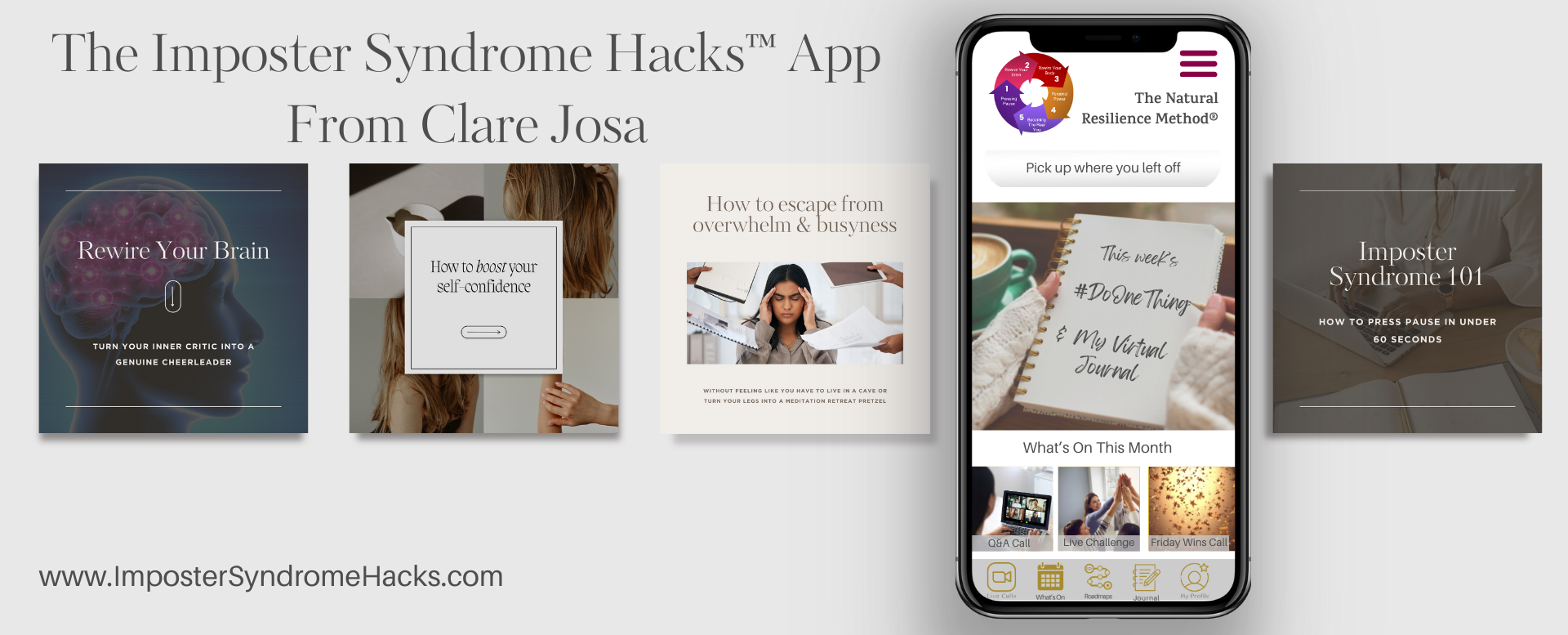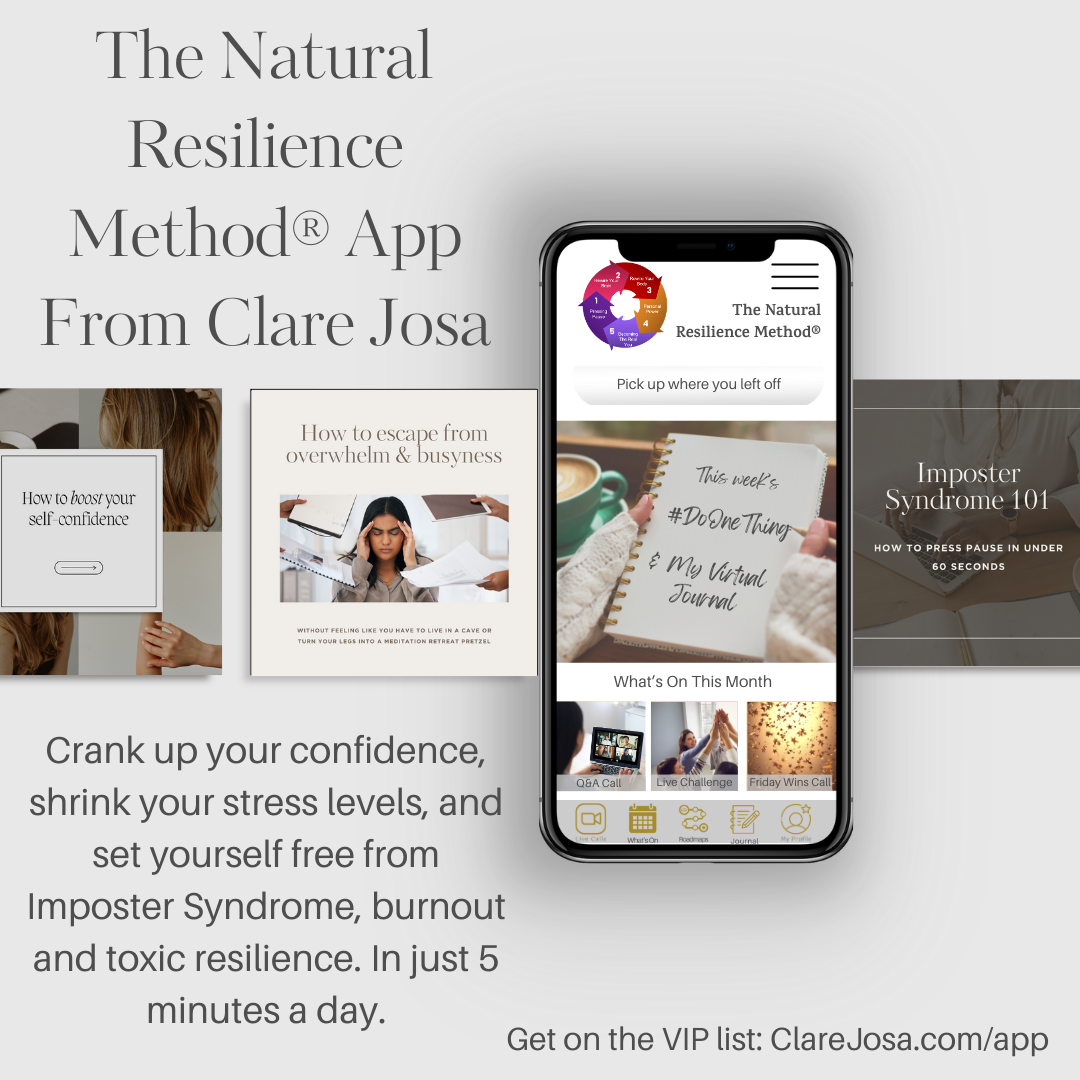1 in 10 of your team members will consider quitting today, due to Imposter Syndrome.
1 in 4 will think about it this week.
Most companies have nothing in place to spot or prevent that. And the taboo and shame around the subject means people don't want to ask their manager for help.
It's time for massive change.
It's Time To To AskClare.ai™
Imagine having a world class Imposter Syndrome Mentor on speed-dial, 24/7, to give you personalised suggestions on how to handle everything from calming your nerves before a board-room pitch, through to practical suggestions for giving tricky feedback to a team member who's wobbling.
And imagine knowing that this advice isn't just a ChatGPT regurgitation of coaching industry platitudes and internet-scraped coping strategies.
It's grounded in 20+ years of research, with proven, actionable strategies, backed by science, with quick-links to additional how-to resources.
Now, imagine it's not just for you: you can scale this for your teams.
Imagine everyone who needs it having instant access to the practical wisdom and proven strategies from perhaps the world's leading brain on the topic of Imposter Syndrome, burnout, and natural resilience. Imagine how that might help them to prevent self-sabotage, to speak up with their brilliant ideas, to feel less stressed, to fulfil their potential.
It's time for AskClare.ai™.
Clare Josa, Global Authority on Imposter Syndrome & Creator of AskClare.ai™
This is so extraordinary that it changes everything.
What happens if you need Imposter Syndrome or confidence help and advice in-the-moment?
If you turn to ChatGPT, you're at the whim of whichever bit of internet myth and fluff its databanks randomly regurgitate.
If you ask Google, you'll be given – at best – coping strategies and 'just reframe it as a good thing', not solutions that actually make a difference.
Wouldn't it be incredible to be able to just send me a message and get instant, personalised feedback and suggestions - strategies that actually work?
That's why we've built AskClare.ai™ for you.
AskClare.ai™ has been trained on my brain, with:
2.1 million of my words & rising
500+ podcast episodes & videos
10 books & 100+ training courses
Proven strategies from thousands of coaching sessions spanning 20+ years

AskClare.ai™ has been trained on 2.1 million of my words (I know – I was blown away by that number, too). And it's growing as we add even more of my work to the model.
But they're not just any old words. They're taken from my books, my training courses, my teachings, my research studies, my proven strategies.
This means that the conversations you have with AskClare.ai™ feel like you're chatting direct with me. It's my voice. My techniques. My insights. My advice.
Tailored just for you. 24/7.
Proven Strategies, Research-Led, Trauma-Informed
It's like a download of my Imposter Syndrome expertise straight to your phone – your Imposter Syndrome Mentor In Your Pocket™ - 24/7.
Instant: Pick Clare's Brain
You ask it questions, and it picks my brain for you, right there and then – giving you the strategies, insights, and tools you need - the exact same ones I would personally recommend, based on 20+ years of specialising in this field.
Personalised, Practical Advice
Need how-to for handling your board meeting pre-pitch nerves? Worrying about tomorrow's client call? Second-guessing that 2-hour report that's taking 2 days? Don't feel you can ask your boss or HR for help? Ask Clare.
Scalable Solutions
Help hundreds for the cost of coaching a handful. AskClare.ai™ is designed to help you to scale proven, confidential, individualised Imposter Syndrome and burnout support, delivering high-impact results, with proven, measurable ROI.
AskClare.ai™ brings the power of my 20+ years of experience to moments that would otherwise go unsupported - quietly transforming confidence from the inside out.
There's still a vital place for certified Imposter Syndrome Practitioners™ and Master Coaches to help you do the deeper, clearing-out work.
But in-the-moment, when you need solutions that work right here, right now, AskClare.ai™ is there for you.
Trauma-informed, no 'accidental therapy', just inspirational, proven strategies, grounded in science, and 20 years of research.
AskClaire.ai™ isn't just Imposter Syndrome-informed virtual coaching or awareness-raising.
It's trauma-informed, evidence-based, grounded in research and science, and trained on 20+ years of thousands of client sessions, supporting them in creating breakthroughs in Imposter Syndrome, confidence, burnout, and resilience, even when they felt like nothing else had worked.
It's not about generic quick tips, or a virtual search engine of my work, or vague, pre-scripted one-size-fits-all suggestions.
AskClare.ai is about:
Scroll down to see examples of what it's like to chat with AskClare.ai™. Unedited. Real conversations. See for yourself the depth of support it can offer you and your teams.
It's about no longer having to struggle through those self-sabotage moments on your own.
You have on-demand, in-the-moment, expert support, 24/7.
What's The Investment?
There are enterprise licence options, and an annual access pass for the public. We want to make this as affordable as possible, whilst still offering the quality and service you deserve. So:
For less than the cost of a 30-minute coaching session with me, you can have my Imposter Syndrome brain in your pocket 24/7 for a whole year. Every strategy. Every internal reset. Every mind-story fear untangled. Every perspective shift. Every moment that might otherwise derail your day.
We're opening access in waves, to ensure a high-quality on-boarding experience. But places will be limited and demand is already high. Licences will be offered on a first-come, first-served basis. Register below today to be in the queue.
For Enterprise licences: after registering your interest, request a free trial – 7 days, 200 questions. No massive sales pitch. Experience it for yourself.
Just imagine the difference that embedding my Imposter Syndrome brain could have for you, your teams, your managers, leaders, and HR professionals, your business, and the world.
Wow.
Where does this fit in your scalable solutions for Imposter Syndrome & burnout?
- 1AskClare.ai™ Is Your First Line Of Support
Quick to implement and seamless with SSO, AskClare.ai™ can be rolled out, team-wide onto your intranet or into a Slack channel, and start making a difference in just a few days. It gives people immediate support while you develop your longer-term action plan. - 2Build Your Dream Team
Who could be your senior-level champion? Who else might be great on a team to lead proactive prevention solutions for Imposter Syndrome and burnout? How can you pre-empt and proactively overcome any potential objections to prioritising tackling this? What information do you need to evidence the business case? We can help you to navigate these and develop the business case, if needed. - 3Measure The Problem & Hidden Drivers
Run a well-designed research study to understand how Imposter Syndrome is impacting your teams, and which quick wins would give you a near-instant improvement on the three amplifiers: Culture, Environment, Habits. Let us know if you want help with this - we’ve already developed proven diagnostic studies for this purpose – built by Clare, who was formerly Head of Market Research for one of the world’s most disruptive brands. - 4Offer Urgent Support To Those Most In Need
Design your study right and it will show you exactly who needs the most urgent support, for example with the Imposter Syndrome Bootcamp™, and who would appreciate a slower process to clear Imposter Syndrome, say, with the 5-minutes-a-day Imposter Syndrome Hacks™ App. - 5Train In-House Coaches - Properly
The study can also allow people to raise their hand to get more specialist training in how to support people in clearing Imposter Syndrome in ways that are proven to be effective, trauma-informed, and which go beyond just self-study and box-ticking. Make sure it includes post-certification support that fulfils your psychological safety obligations, both to your team members and to the coaches. Our certified Imposter Syndrome Practitioner™ and Master Coach programmes do all of this. - 6Formally Launch Your Initiative
Once your coaches are nearly-ready, that's the right point to have keynote-style event, not as step one. Use it for maximum impact to launch your initiative. Perhaps bring in a professional speaker like Clare. Make a fuss about what you're going to be achieving and get people excited. Potentially include line manager training and also an expert-supported review of your performance appraisal processes, to make them Imposter Syndrome-informed. - 7Measure The Impact & Refine
12 months on, measure the impact your interventions have had - not just on Imposter Syndrome rates, but on other key metrics for you, such as performance, productivity, stress-related absenteeism, sabbatical rates, and staff retention. Re-assess the three amplifiers (Culture, Environment, Habits) and agree your next-phase actions.
Want to see what AskClare.ai™ can do?
Here are examples of conversations we have had with it. The numbers are clickable links for users, taking them straight to practical, proven resources, tied in with that suggestion.
And if you'd like us to ask it a question for you, there's the option to do that at the end of the questions on the waiting list registration form. We'll send you the answers.
Here are the screenshots of this interaction. The numbers are links to resources and references, for people who want to dive right in and take more action.

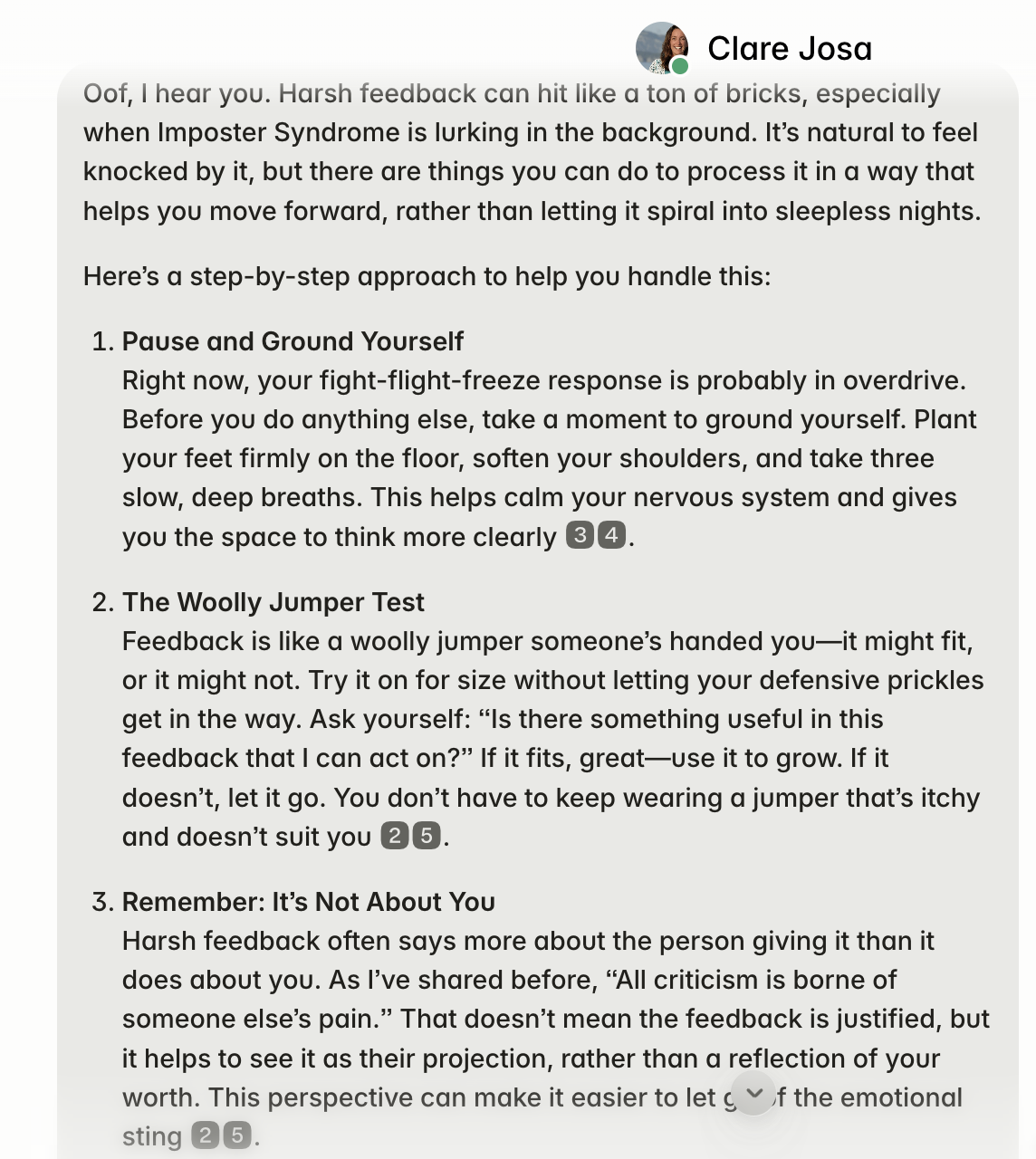
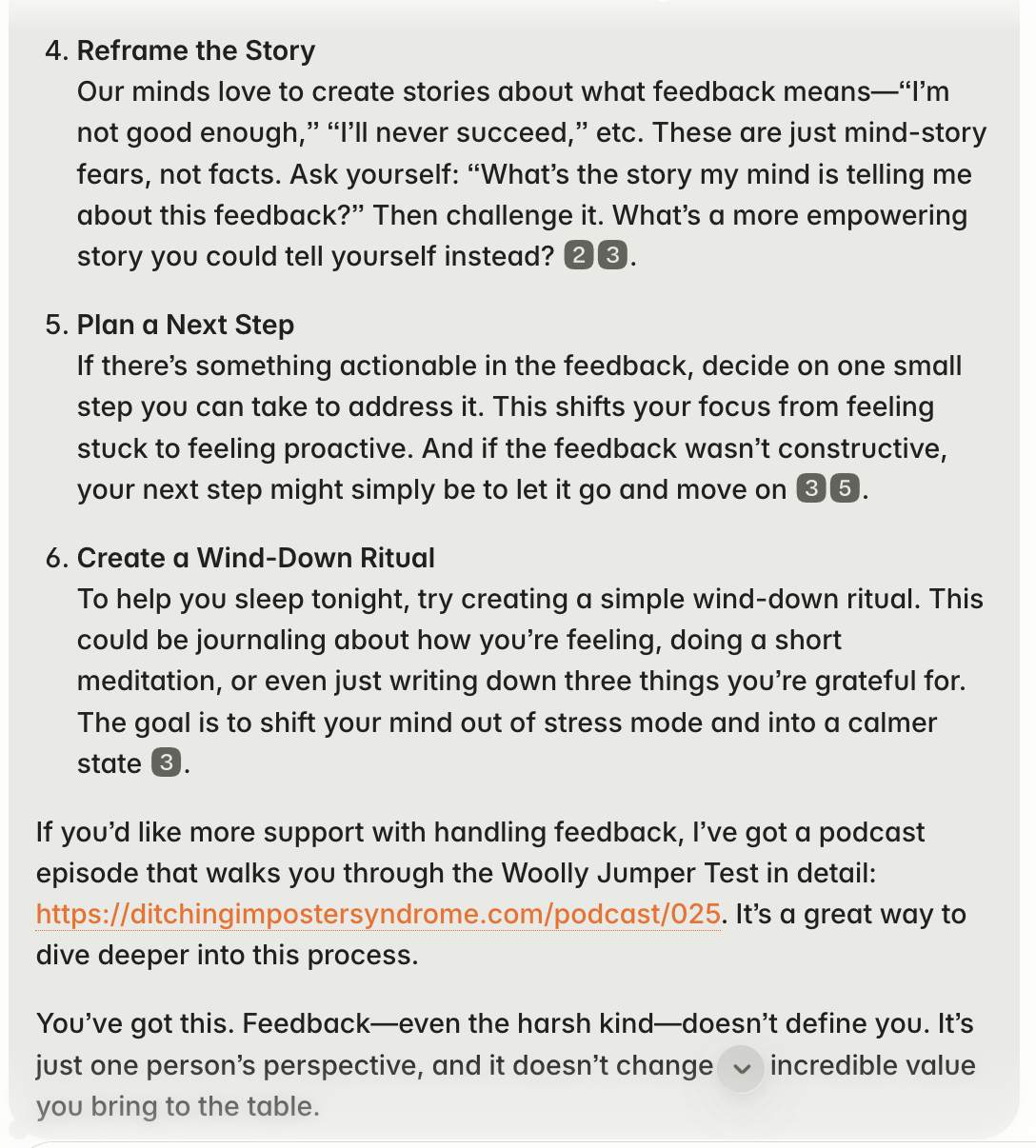

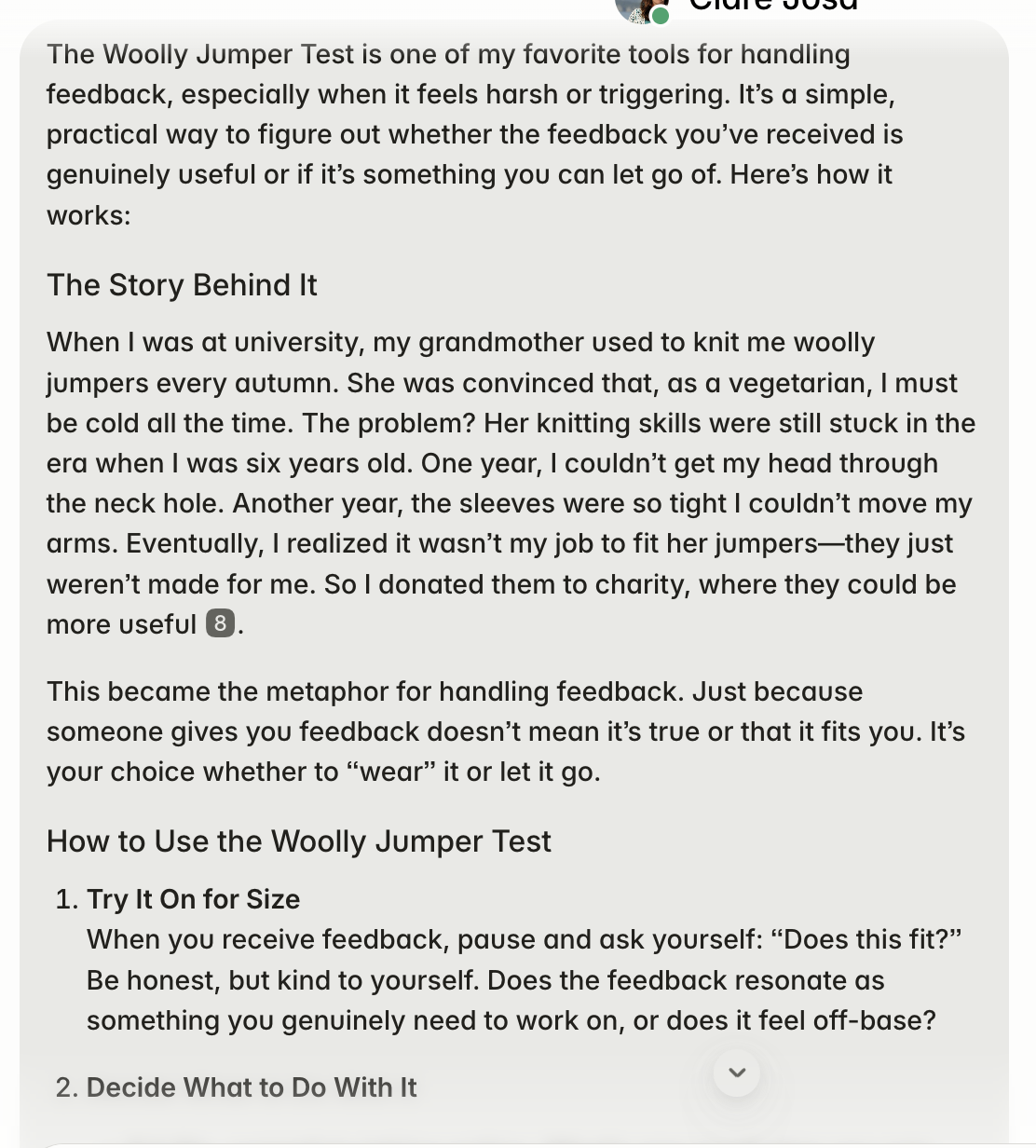
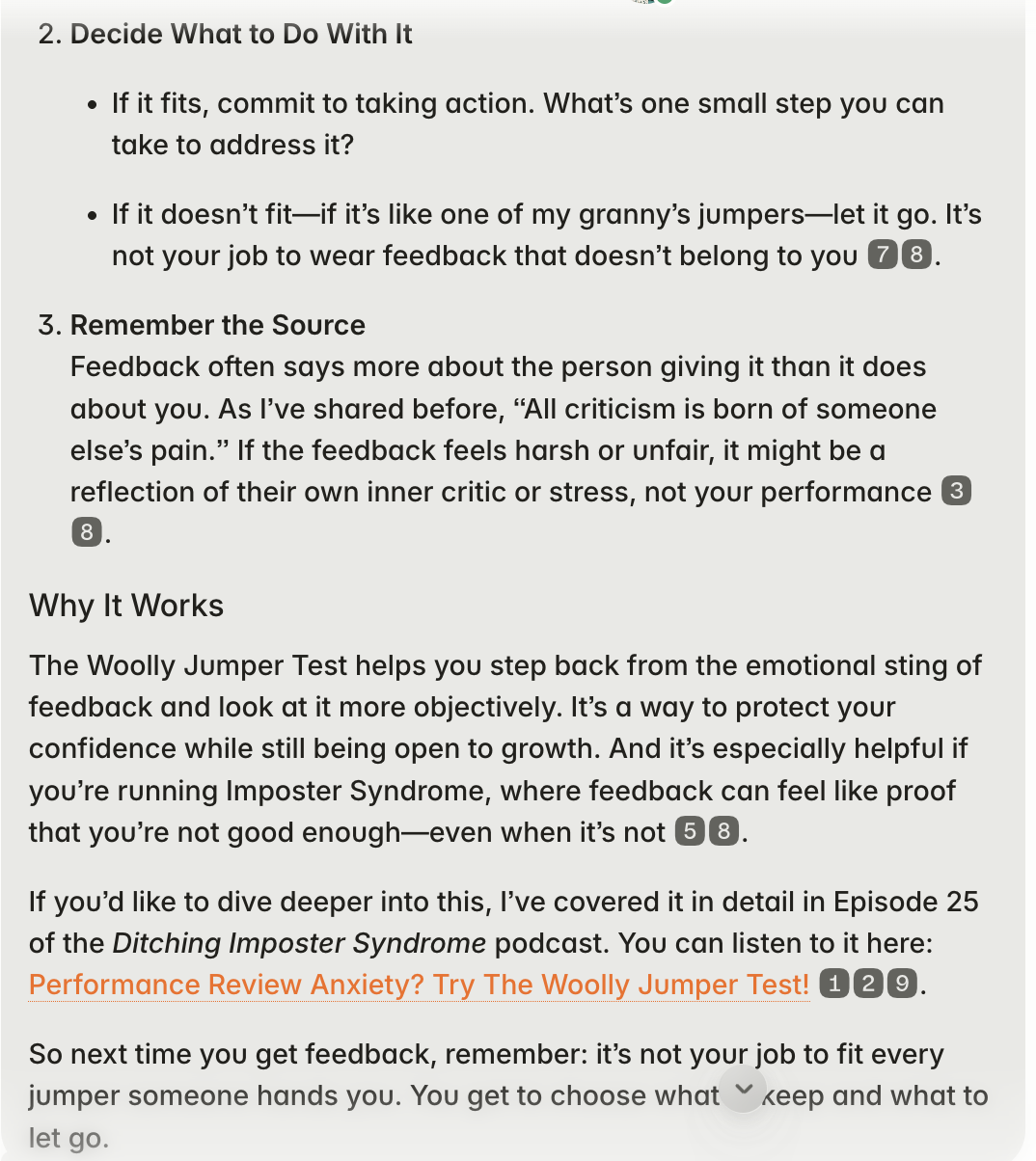
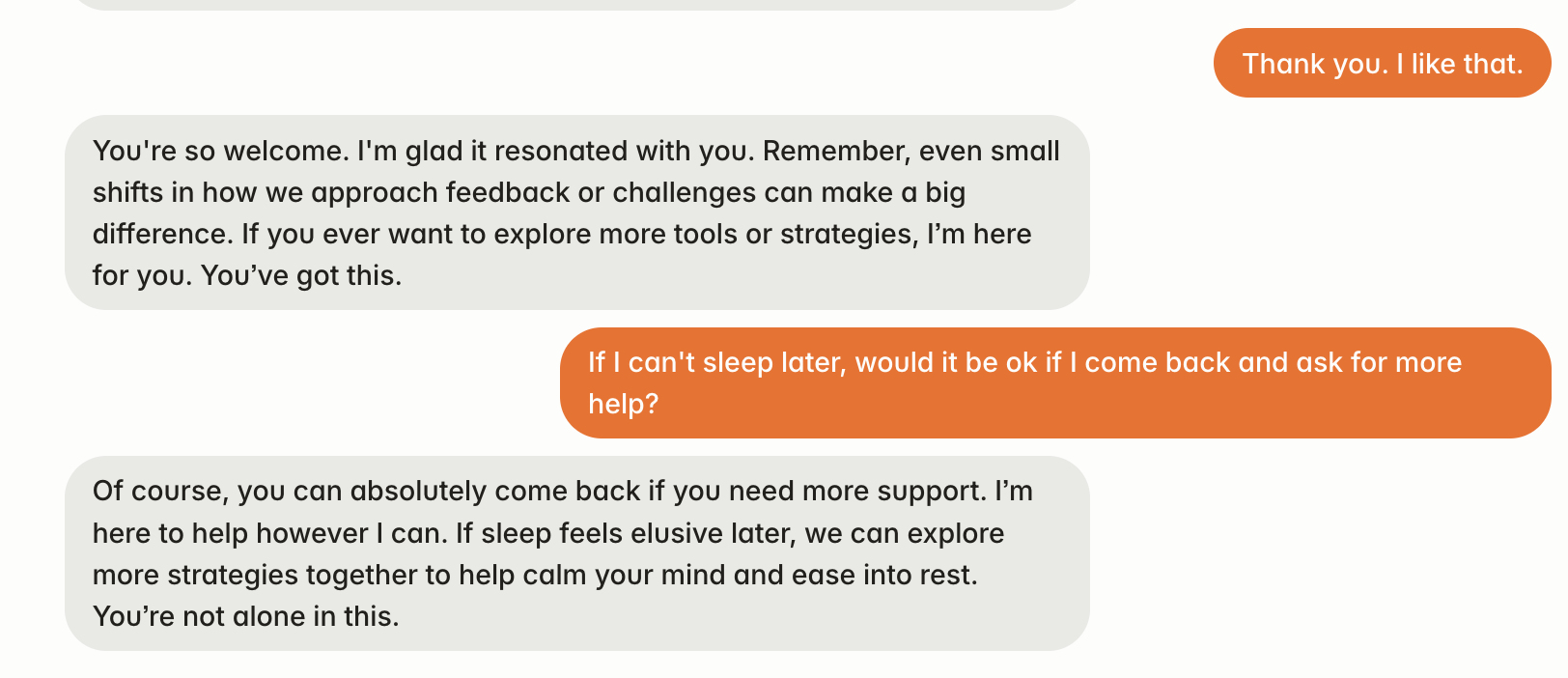
Here are the screenshots of this interaction. The numbers are links to resources and references, for people who want to dive right in and take more action.

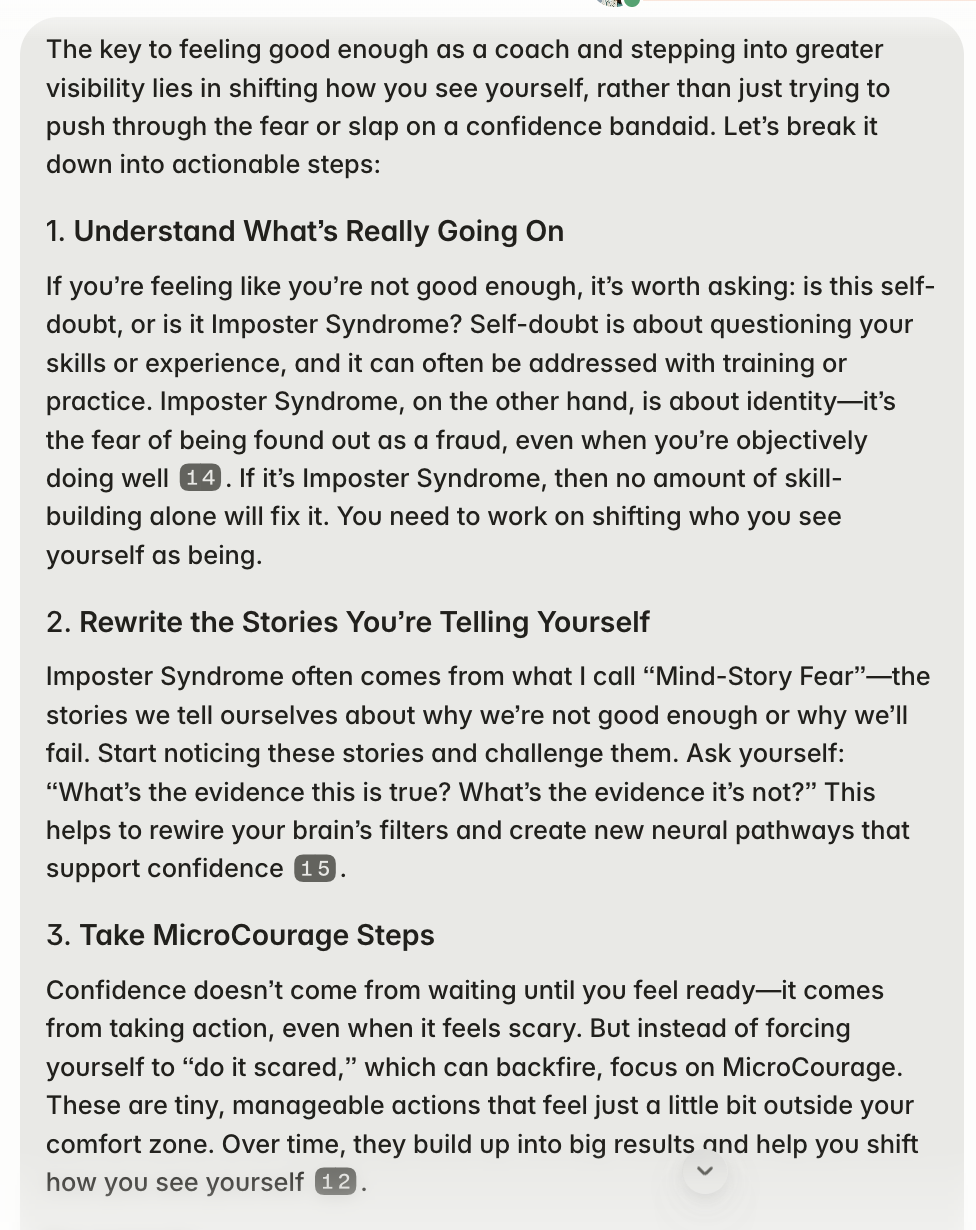
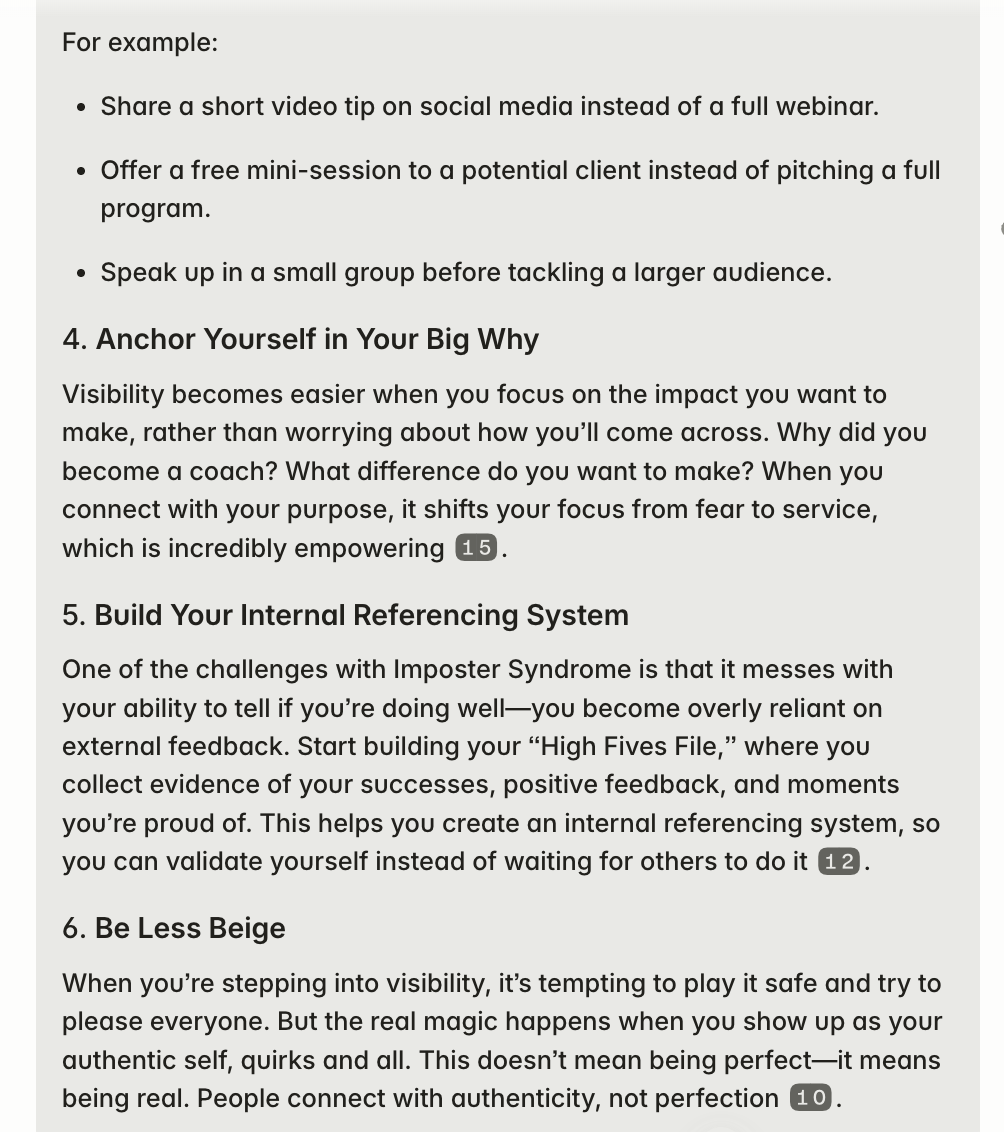
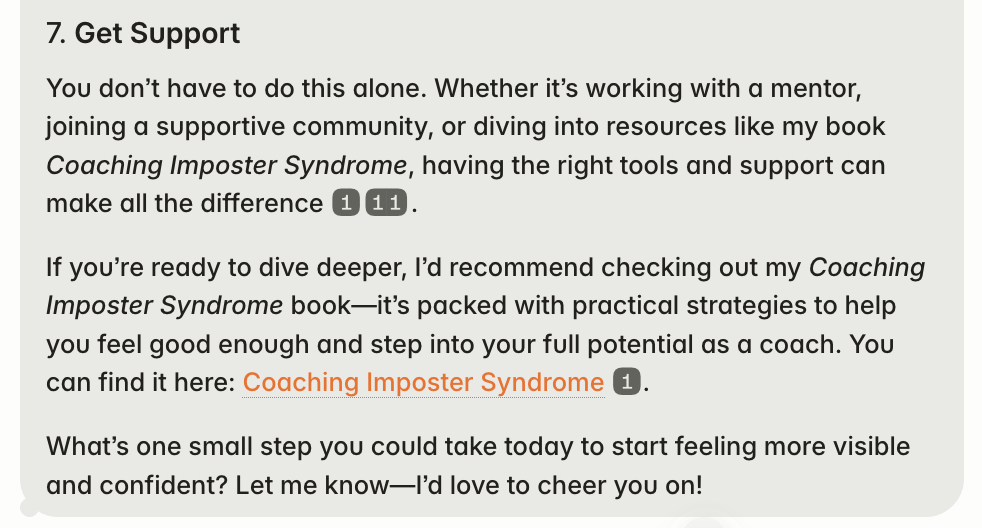
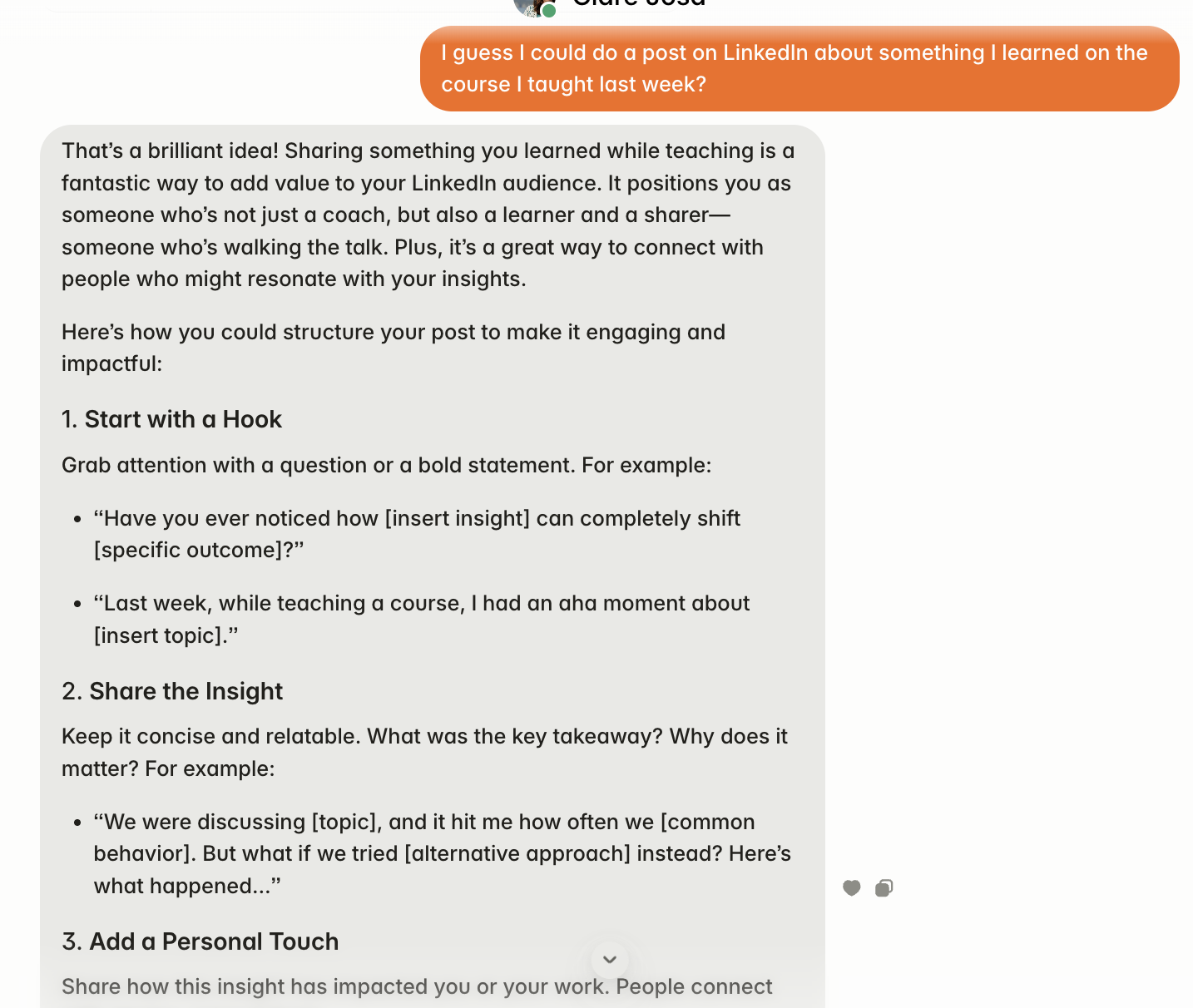
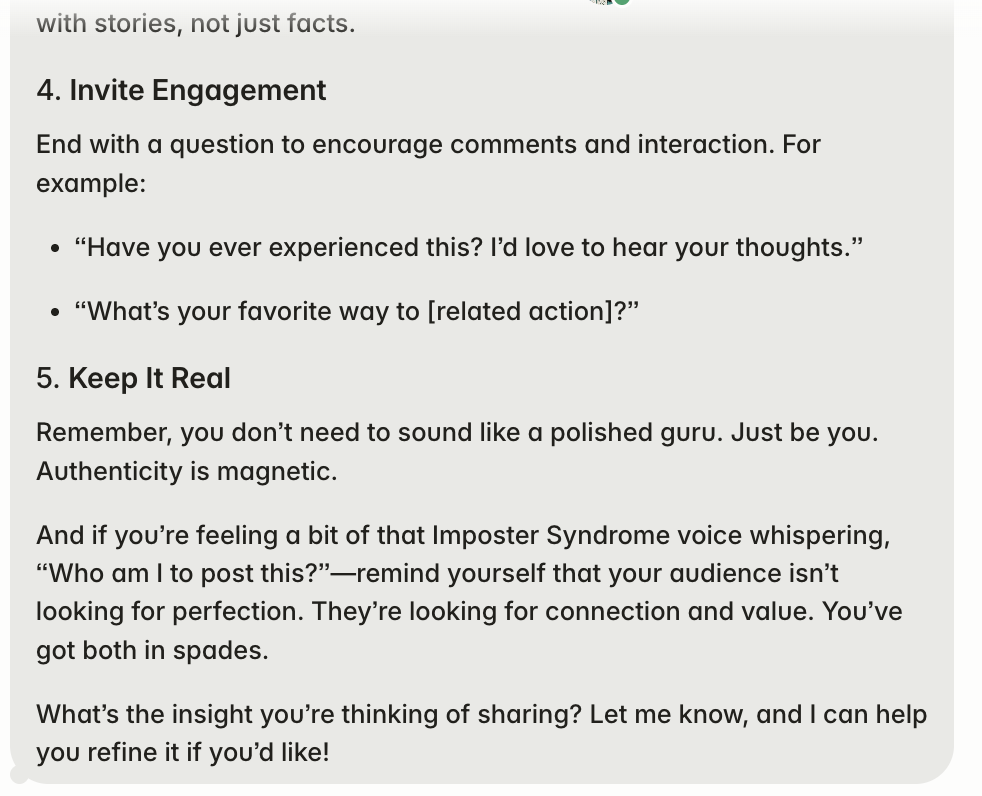
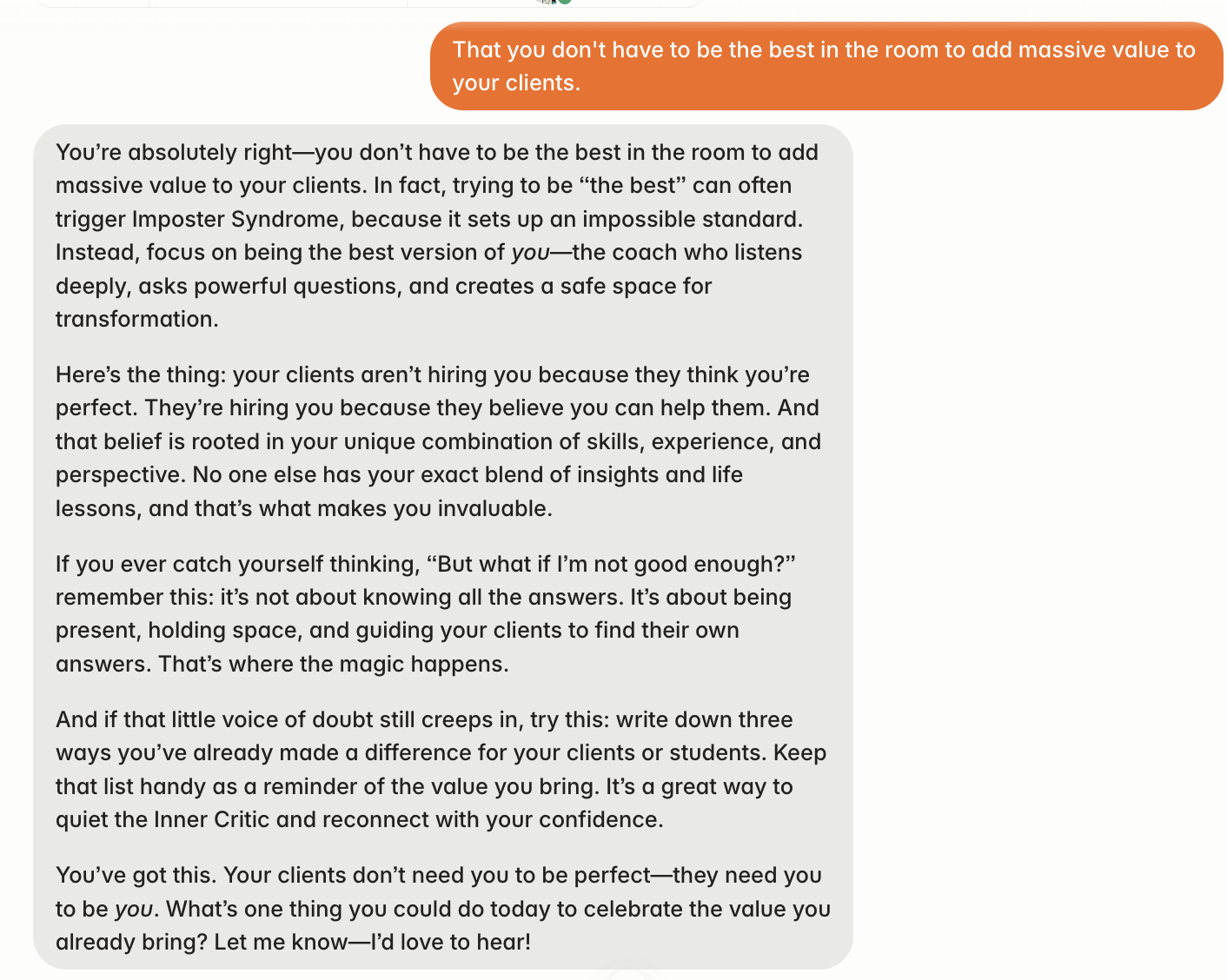
Here are the screenshots of this interaction. The numbers are links to resources and references, for people who want to dive right in and take more action.

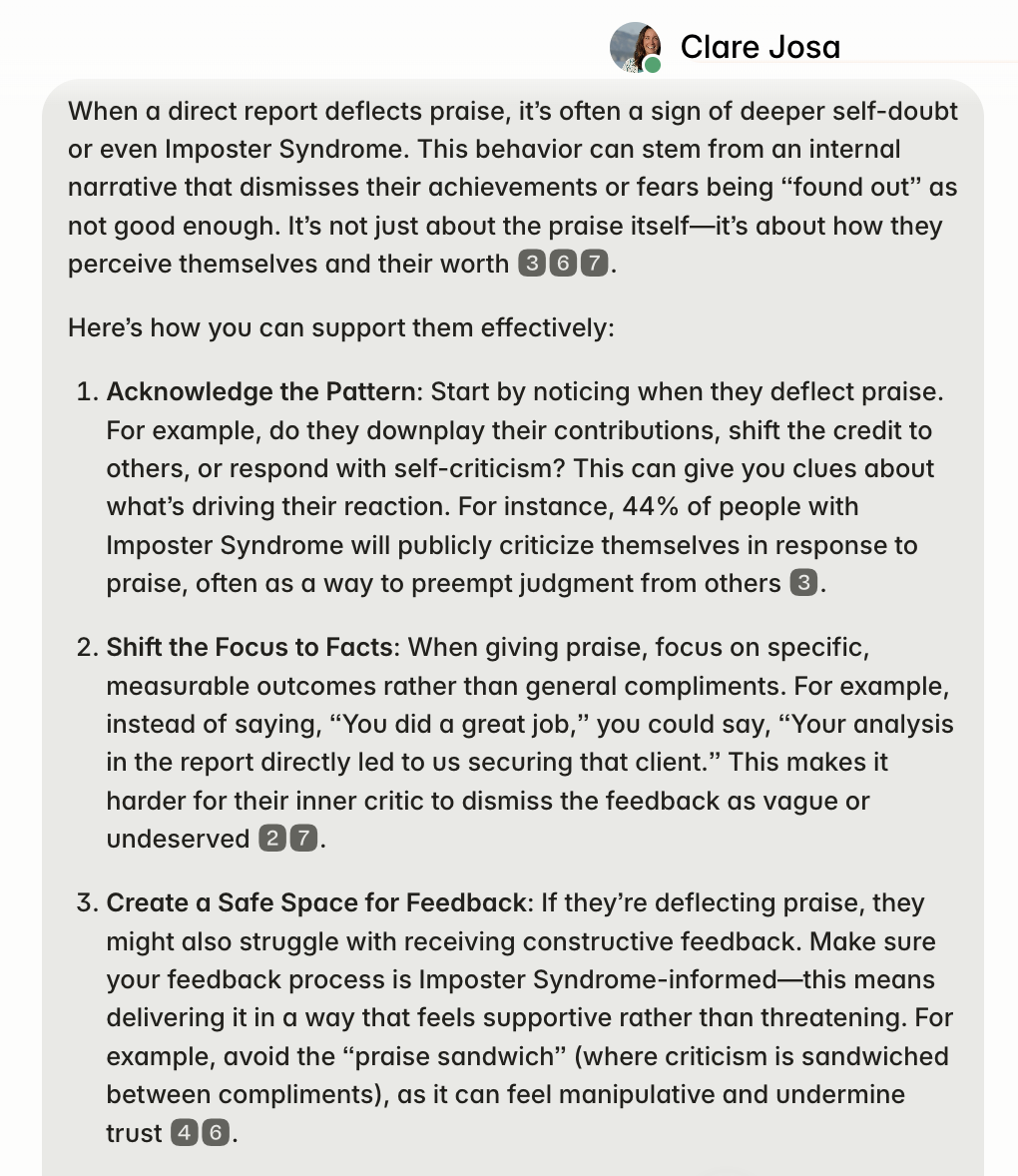
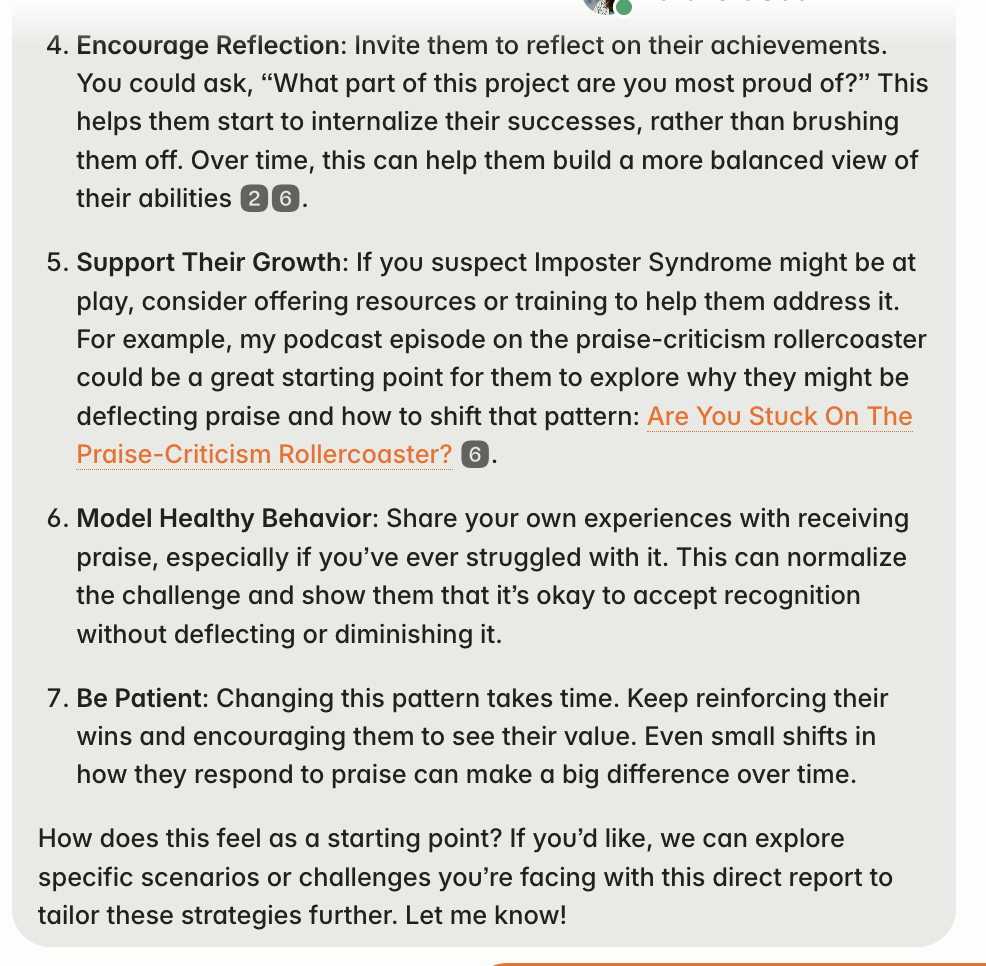

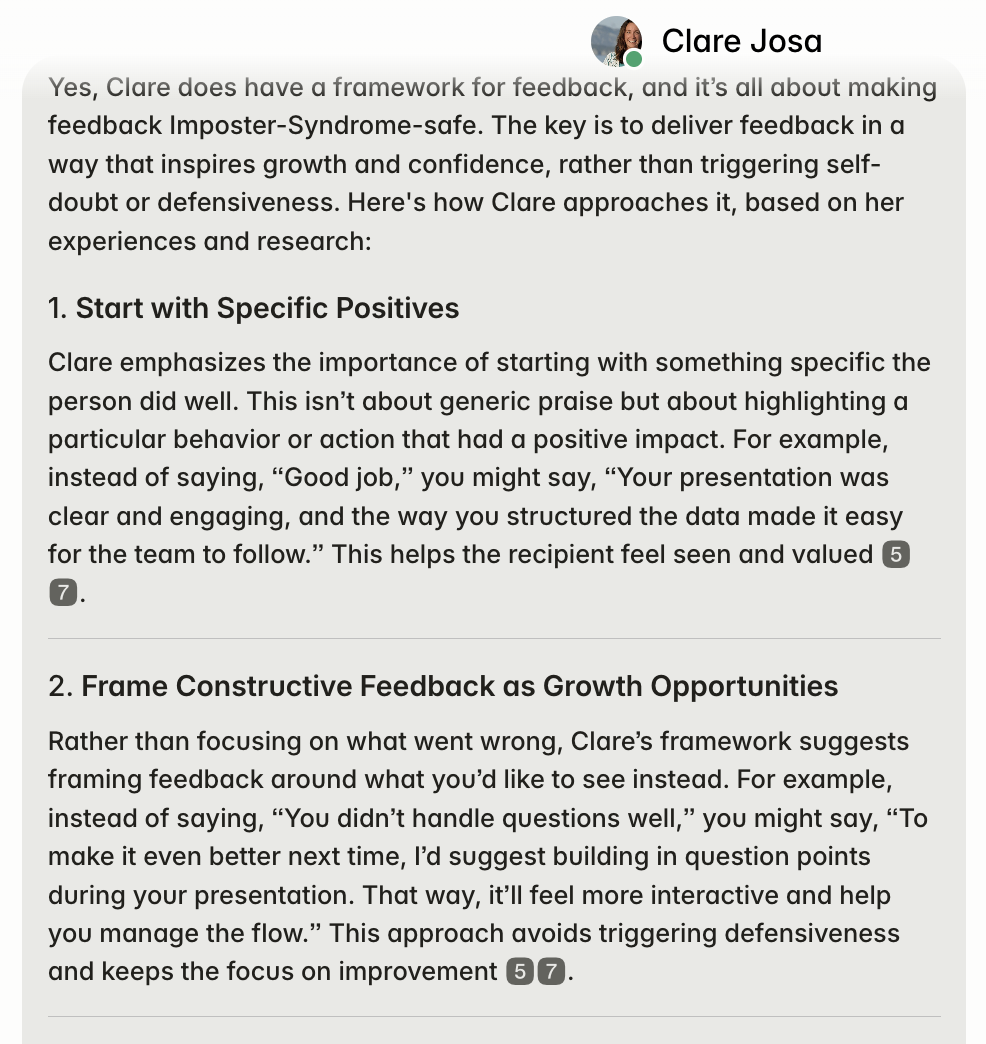
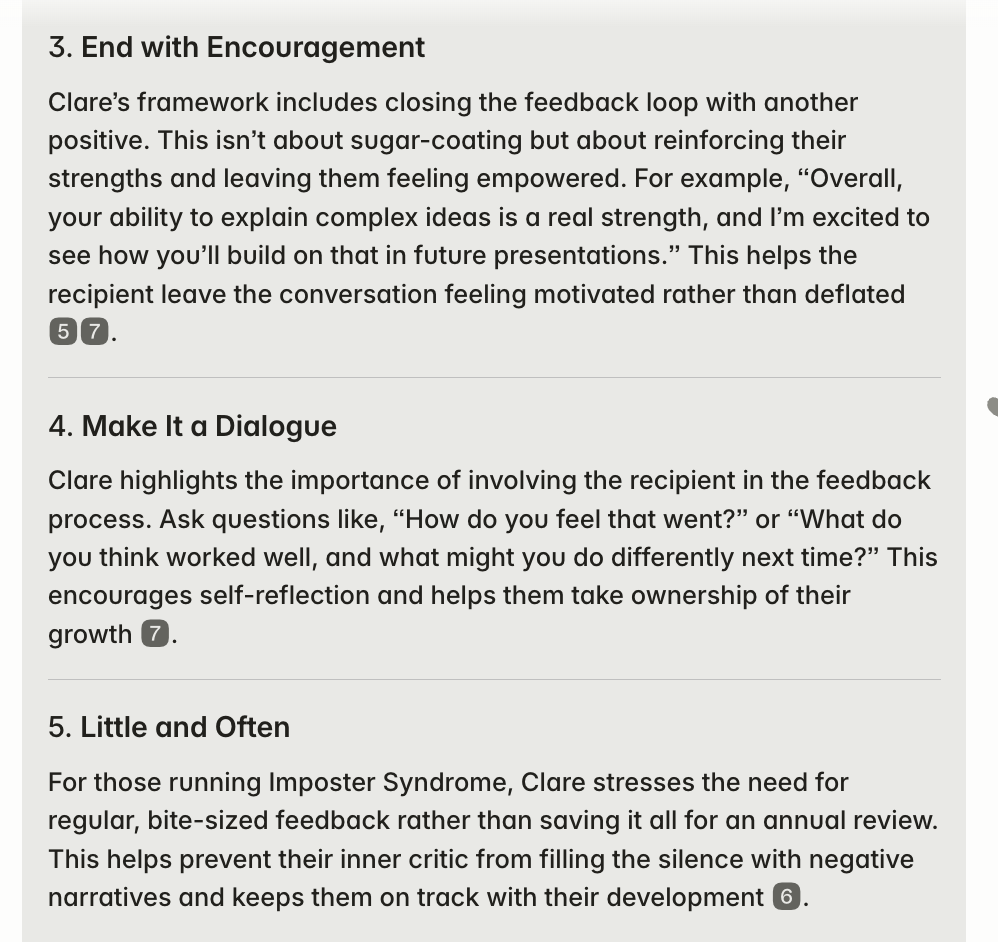
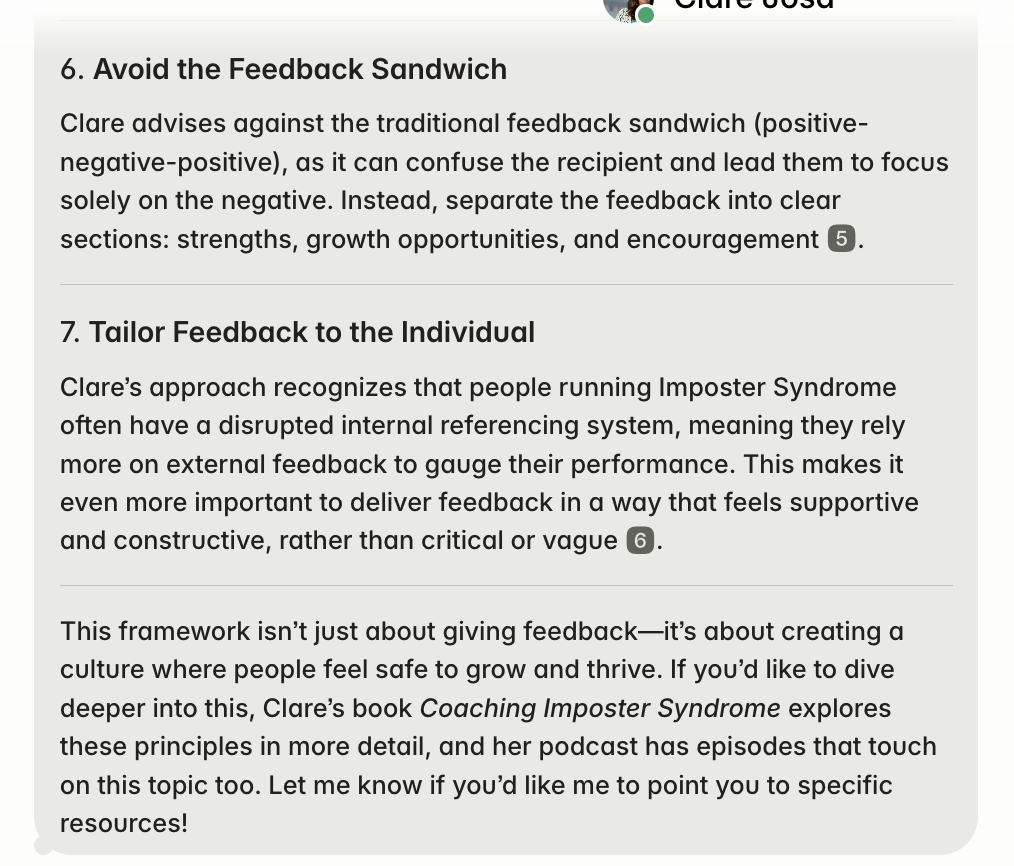
Here are the screenshots of this interaction. The numbers are links to resources and references, for people who want to dive right in and take more action.

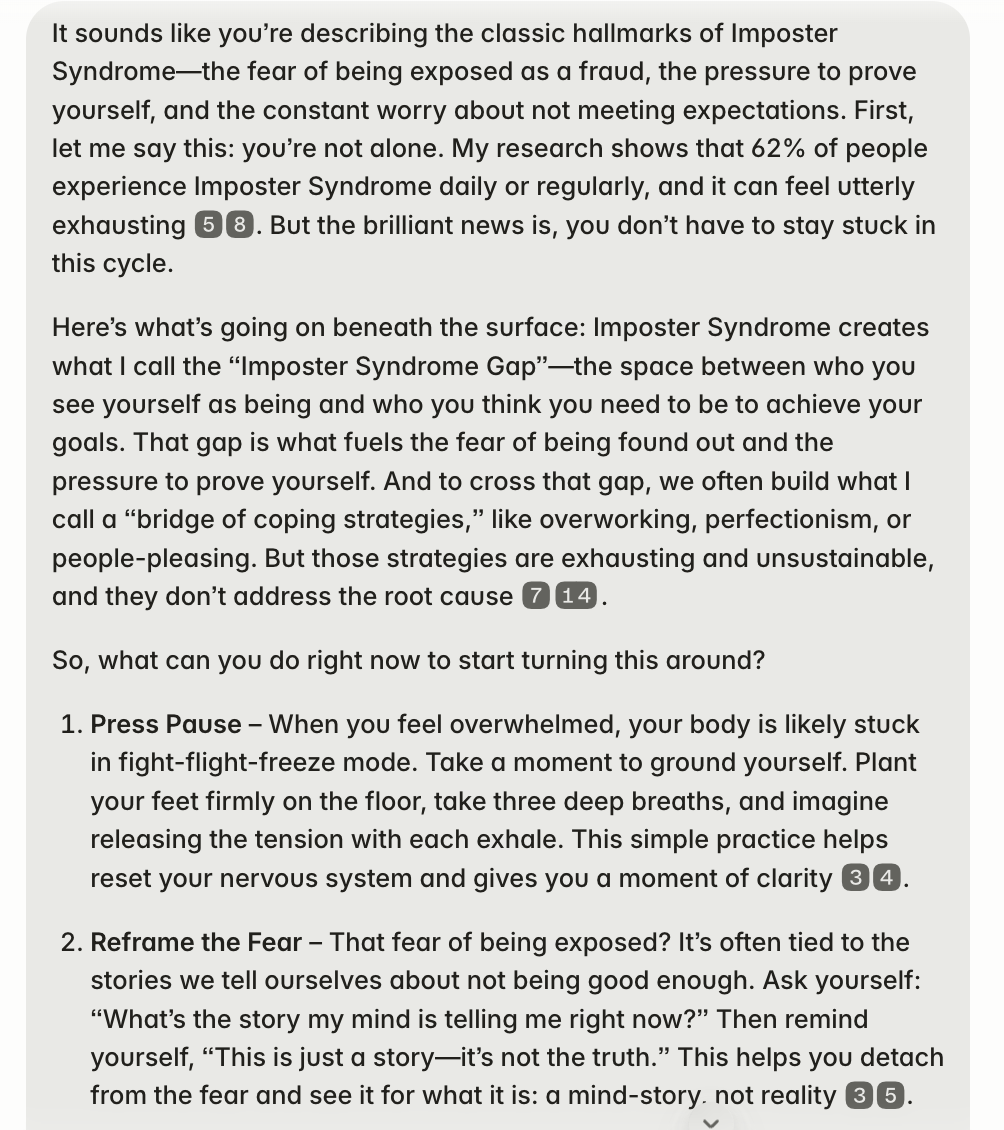
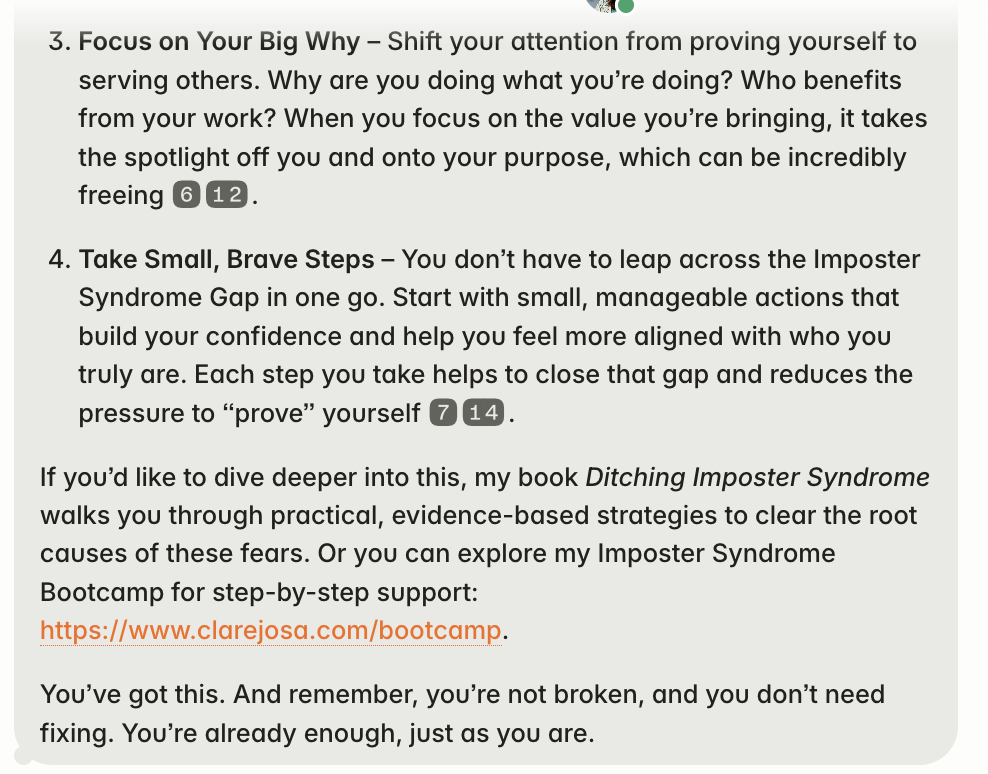

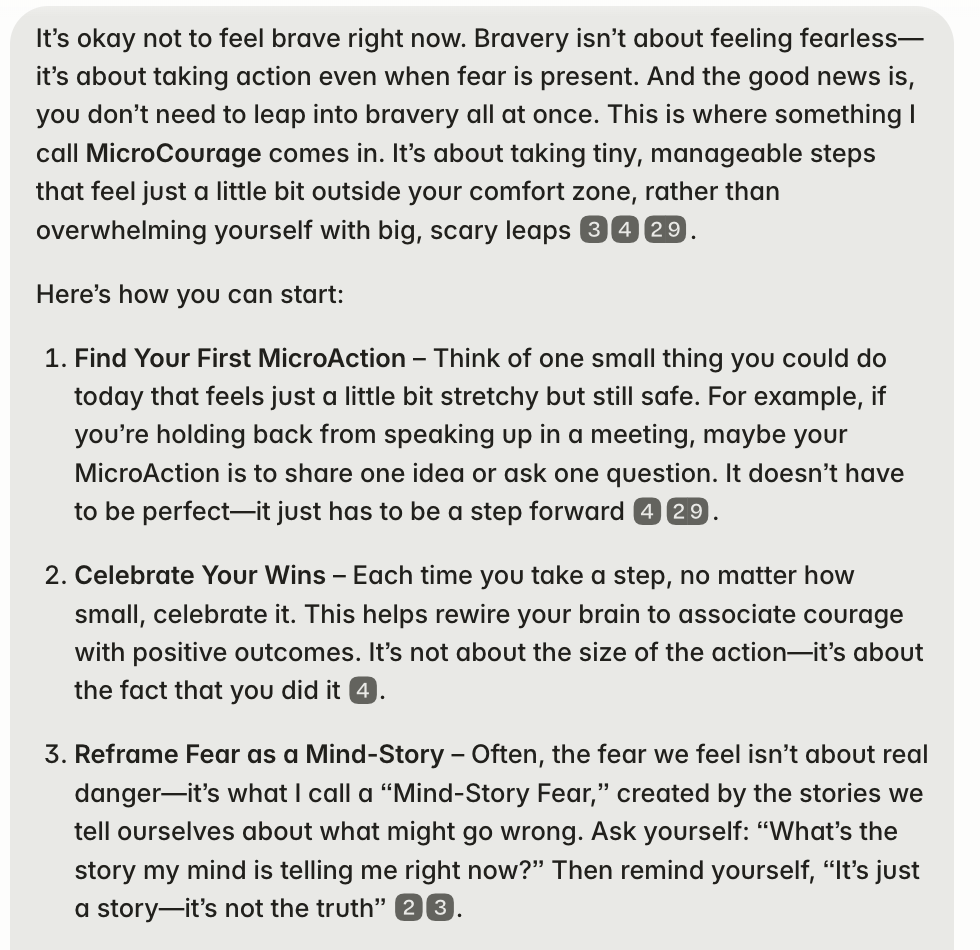
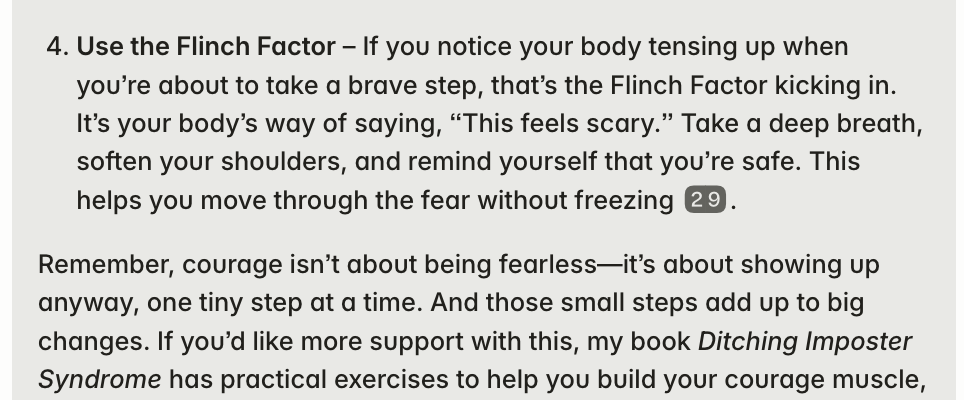
Here are the screenshots of this interaction. The numbers are links to resources and references, for people who want to dive right in and take more action.
![It’s okay not to feel brave right now. Bravery isn’t about feeling fearless—it’s about taking action even when fear is present. And the good news is, you don’t need to leap into bravery all at once. This is where something I call **MicroCourage** comes in. It’s about taking tiny, manageable steps that feel just a little bit outside your comfort zone, rather than overwhelming yourself with big, scary leaps [3][4][29]. Here’s how you can start: 1. **Find Your First MicroAction** – Think of one small thing you could do today that feels just a little bit stretchy but still safe. For example, if you’re holding back from speaking up in a meeting, maybe your MicroAction is to share one idea or ask one question. It doesn’t have to be perfect—it just has to be a step forward [4][29]. 2. **Celebrate Your Wins** – Each time you take a step, no matter how small, celebrate it. This helps rewire your brain to associate courage with positive outcomes. It’s not about the size of the action—it’s about the fact that you did it [4]. 3. **Reframe Fear as a Mind-Story** – Often, the fear we feel isn’t about real danger—it’s what I call a “Mind-Story Fear,” created by the stories we tell ourselves about what might go wrong. Ask yourself: “What’s the story my mind is telling me right now?” Then remind yourself, “It’s just a story—it’s not the truth” [2][3]. 4. **Use the Flinch Factor** – If you notice your body tensing up when you’re about to take a brave step, that’s the Flinch Factor kicking in. It’s your body’s way of saying, “This feels scary.” Take a deep breath, soften your shoulders, and remind yourself that you’re safe. This helps you move through the fear without freezing [29]. Remember, courage isn’t about being fearless—it’s about showing up anyway, one tiny step at a time. And those small steps add up to big changes. If you’d like more support with this, my book *Ditching Imposter Syndrome* has practical exercises to help you build your courage muscle, or you can explore the Sixty-Second Courage Creator training inside the Imposter Syndrome Hacks™ App - https://www.impostersyndromehacks.com. You’ve got this.](https://ditchingimpostersyndrome.com/wp-content/uploads/2025/04/Screenshot-2025-04-25-at-15.14.31.png)
![It’s okay not to feel brave right now. Bravery isn’t about feeling fearless—it’s about taking action even when fear is present. And the good news is, you don’t need to leap into bravery all at once. This is where something I call **MicroCourage** comes in. It’s about taking tiny, manageable steps that feel just a little bit outside your comfort zone, rather than overwhelming yourself with big, scary leaps [3][4][29]. Here’s how you can start: 1. **Find Your First MicroAction** – Think of one small thing you could do today that feels just a little bit stretchy but still safe. For example, if you’re holding back from speaking up in a meeting, maybe your MicroAction is to share one idea or ask one question. It doesn’t have to be perfect—it just has to be a step forward [4][29]. 2. **Celebrate Your Wins** – Each time you take a step, no matter how small, celebrate it. This helps rewire your brain to associate courage with positive outcomes. It’s not about the size of the action—it’s about the fact that you did it [4]. 3. **Reframe Fear as a Mind-Story** – Often, the fear we feel isn’t about real danger—it’s what I call a “Mind-Story Fear,” created by the stories we tell ourselves about what might go wrong. Ask yourself: “What’s the story my mind is telling me right now?” Then remind yourself, “It’s just a story—it’s not the truth” [2][3]. 4. **Use the Flinch Factor** – If you notice your body tensing up when you’re about to take a brave step, that’s the Flinch Factor kicking in. It’s your body’s way of saying, “This feels scary.” Take a deep breath, soften your shoulders, and remind yourself that you’re safe. This helps you move through the fear without freezing [29]. Remember, courage isn’t about being fearless—it’s about showing up anyway, one tiny step at a time. And those small steps add up to big changes. If you’d like more support with this, my book *Ditching Imposter Syndrome* has practical exercises to help you build your courage muscle, or you can explore the Sixty-Second Courage Creator training inside the Imposter Syndrome Hacks™ App - https://www.impostersyndromehacks.com. You’ve got this.](https://ditchingimpostersyndrome.com/wp-content/uploads/2025/04/Screenshot-2025-04-25-at-15.14.41.png)
![It’s okay not to feel brave right now. Bravery isn’t about feeling fearless—it’s about taking action even when fear is present. And the good news is, you don’t need to leap into bravery all at once. This is where something I call **MicroCourage** comes in. It’s about taking tiny, manageable steps that feel just a little bit outside your comfort zone, rather than overwhelming yourself with big, scary leaps [3][4][29]. Here’s how you can start: 1. **Find Your First MicroAction** – Think of one small thing you could do today that feels just a little bit stretchy but still safe. For example, if you’re holding back from speaking up in a meeting, maybe your MicroAction is to share one idea or ask one question. It doesn’t have to be perfect—it just has to be a step forward [4][29]. 2. **Celebrate Your Wins** – Each time you take a step, no matter how small, celebrate it. This helps rewire your brain to associate courage with positive outcomes. It’s not about the size of the action—it’s about the fact that you did it [4]. 3. **Reframe Fear as a Mind-Story** – Often, the fear we feel isn’t about real danger—it’s what I call a “Mind-Story Fear,” created by the stories we tell ourselves about what might go wrong. Ask yourself: “What’s the story my mind is telling me right now?” Then remind yourself, “It’s just a story—it’s not the truth” [2][3]. 4. **Use the Flinch Factor** – If you notice your body tensing up when you’re about to take a brave step, that’s the Flinch Factor kicking in. It’s your body’s way of saying, “This feels scary.” Take a deep breath, soften your shoulders, and remind yourself that you’re safe. This helps you move through the fear without freezing [29]. Remember, courage isn’t about being fearless—it’s about showing up anyway, one tiny step at a time. And those small steps add up to big changes. If you’d like more support with this, my book *Ditching Imposter Syndrome* has practical exercises to help you build your courage muscle, or you can explore the Sixty-Second Courage Creator training inside the Imposter Syndrome Hacks™ App - https://www.impostersyndromehacks.com. You’ve got this.](https://ditchingimpostersyndrome.com/wp-content/uploads/2025/04/Screenshot-2025-04-25-at-15.14.50.png)
Here are the screenshots of this interaction. The numbers are links to resources and references, for people who want to dive right in and take more action.
![It’s okay not to feel brave right now. Bravery isn’t about feeling fearless—it’s about taking action even when fear is present. And the good news is, you don’t need to leap into bravery all at once. This is where something I call **MicroCourage** comes in. It’s about taking tiny, manageable steps that feel just a little bit outside your comfort zone, rather than overwhelming yourself with big, scary leaps [3][4][29]. Here’s how you can start: 1. **Find Your First MicroAction** – Think of one small thing you could do today that feels just a little bit stretchy but still safe. For example, if you’re holding back from speaking up in a meeting, maybe your MicroAction is to share one idea or ask one question. It doesn’t have to be perfect—it just has to be a step forward [4][29]. 2. **Celebrate Your Wins** – Each time you take a step, no matter how small, celebrate it. This helps rewire your brain to associate courage with positive outcomes. It’s not about the size of the action—it’s about the fact that you did it [4]. 3. **Reframe Fear as a Mind-Story** – Often, the fear we feel isn’t about real danger—it’s what I call a “Mind-Story Fear,” created by the stories we tell ourselves about what might go wrong. Ask yourself: “What’s the story my mind is telling me right now?” Then remind yourself, “It’s just a story—it’s not the truth” [2][3]. 4. **Use the Flinch Factor** – If you notice your body tensing up when you’re about to take a brave step, that’s the Flinch Factor kicking in. It’s your body’s way of saying, “This feels scary.” Take a deep breath, soften your shoulders, and remind yourself that you’re safe. This helps you move through the fear without freezing [29]. Remember, courage isn’t about being fearless—it’s about showing up anyway, one tiny step at a time. And those small steps add up to big changes. If you’d like more support with this, my book *Ditching Imposter Syndrome* has practical exercises to help you build your courage muscle, or you can explore the Sixty-Second Courage Creator training inside the Imposter Syndrome Hacks™ App - https://www.impostersyndromehacks.com. You’ve got this.](https://ditchingimpostersyndrome.com/wp-content/uploads/2025/04/Screenshot-2025-04-25-at-15.14.57.png)
![It’s okay not to feel brave right now. Bravery isn’t about feeling fearless—it’s about taking action even when fear is present. And the good news is, you don’t need to leap into bravery all at once. This is where something I call **MicroCourage** comes in. It’s about taking tiny, manageable steps that feel just a little bit outside your comfort zone, rather than overwhelming yourself with big, scary leaps [3][4][29]. Here’s how you can start: 1. **Find Your First MicroAction** – Think of one small thing you could do today that feels just a little bit stretchy but still safe. For example, if you’re holding back from speaking up in a meeting, maybe your MicroAction is to share one idea or ask one question. It doesn’t have to be perfect—it just has to be a step forward [4][29]. 2. **Celebrate Your Wins** – Each time you take a step, no matter how small, celebrate it. This helps rewire your brain to associate courage with positive outcomes. It’s not about the size of the action—it’s about the fact that you did it [4]. 3. **Reframe Fear as a Mind-Story** – Often, the fear we feel isn’t about real danger—it’s what I call a “Mind-Story Fear,” created by the stories we tell ourselves about what might go wrong. Ask yourself: “What’s the story my mind is telling me right now?” Then remind yourself, “It’s just a story—it’s not the truth” [2][3]. 4. **Use the Flinch Factor** – If you notice your body tensing up when you’re about to take a brave step, that’s the Flinch Factor kicking in. It’s your body’s way of saying, “This feels scary.” Take a deep breath, soften your shoulders, and remind yourself that you’re safe. This helps you move through the fear without freezing [29]. Remember, courage isn’t about being fearless—it’s about showing up anyway, one tiny step at a time. And those small steps add up to big changes. If you’d like more support with this, my book *Ditching Imposter Syndrome* has practical exercises to help you build your courage muscle, or you can explore the Sixty-Second Courage Creator training inside the Imposter Syndrome Hacks™ App - https://www.impostersyndromehacks.com. You’ve got this.](https://ditchingimpostersyndrome.com/wp-content/uploads/2025/04/Screenshot-2025-04-25-at-15.15.05.png)
![It’s okay not to feel brave right now. Bravery isn’t about feeling fearless—it’s about taking action even when fear is present. And the good news is, you don’t need to leap into bravery all at once. This is where something I call **MicroCourage** comes in. It’s about taking tiny, manageable steps that feel just a little bit outside your comfort zone, rather than overwhelming yourself with big, scary leaps [3][4][29]. Here’s how you can start: 1. **Find Your First MicroAction** – Think of one small thing you could do today that feels just a little bit stretchy but still safe. For example, if you’re holding back from speaking up in a meeting, maybe your MicroAction is to share one idea or ask one question. It doesn’t have to be perfect—it just has to be a step forward [4][29]. 2. **Celebrate Your Wins** – Each time you take a step, no matter how small, celebrate it. This helps rewire your brain to associate courage with positive outcomes. It’s not about the size of the action—it’s about the fact that you did it [4]. 3. **Reframe Fear as a Mind-Story** – Often, the fear we feel isn’t about real danger—it’s what I call a “Mind-Story Fear,” created by the stories we tell ourselves about what might go wrong. Ask yourself: “What’s the story my mind is telling me right now?” Then remind yourself, “It’s just a story—it’s not the truth” [2][3]. 4. **Use the Flinch Factor** – If you notice your body tensing up when you’re about to take a brave step, that’s the Flinch Factor kicking in. It’s your body’s way of saying, “This feels scary.” Take a deep breath, soften your shoulders, and remind yourself that you’re safe. This helps you move through the fear without freezing [29]. Remember, courage isn’t about being fearless—it’s about showing up anyway, one tiny step at a time. And those small steps add up to big changes. If you’d like more support with this, my book *Ditching Imposter Syndrome* has practical exercises to help you build your courage muscle, or you can explore the Sixty-Second Courage Creator training inside the Imposter Syndrome Hacks™ App - https://www.impostersyndromehacks.com. You’ve got this.](https://ditchingimpostersyndrome.com/wp-content/uploads/2025/04/Screenshot-2025-04-25-at-15.15.13.png)
Here are the screenshots of this interaction. The numbers are links to resources and references, for people who want to dive right in and take more action.
![It’s okay not to feel brave right now. Bravery isn’t about feeling fearless—it’s about taking action even when fear is present. And the good news is, you don’t need to leap into bravery all at once. This is where something I call **MicroCourage** comes in. It’s about taking tiny, manageable steps that feel just a little bit outside your comfort zone, rather than overwhelming yourself with big, scary leaps [3][4][29]. Here’s how you can start: 1. **Find Your First MicroAction** – Think of one small thing you could do today that feels just a little bit stretchy but still safe. For example, if you’re holding back from speaking up in a meeting, maybe your MicroAction is to share one idea or ask one question. It doesn’t have to be perfect—it just has to be a step forward [4][29]. 2. **Celebrate Your Wins** – Each time you take a step, no matter how small, celebrate it. This helps rewire your brain to associate courage with positive outcomes. It’s not about the size of the action—it’s about the fact that you did it [4]. 3. **Reframe Fear as a Mind-Story** – Often, the fear we feel isn’t about real danger—it’s what I call a “Mind-Story Fear,” created by the stories we tell ourselves about what might go wrong. Ask yourself: “What’s the story my mind is telling me right now?” Then remind yourself, “It’s just a story—it’s not the truth” [2][3]. 4. **Use the Flinch Factor** – If you notice your body tensing up when you’re about to take a brave step, that’s the Flinch Factor kicking in. It’s your body’s way of saying, “This feels scary.” Take a deep breath, soften your shoulders, and remind yourself that you’re safe. This helps you move through the fear without freezing [29]. Remember, courage isn’t about being fearless—it’s about showing up anyway, one tiny step at a time. And those small steps add up to big changes. If you’d like more support with this, my book *Ditching Imposter Syndrome* has practical exercises to help you build your courage muscle, or you can explore the Sixty-Second Courage Creator training inside the Imposter Syndrome Hacks™ App - https://www.impostersyndromehacks.com. You’ve got this.](https://ditchingimpostersyndrome.com/wp-content/uploads/2025/04/Screenshot-2025-04-25-at-15.15.26.png)
![It’s okay not to feel brave right now. Bravery isn’t about feeling fearless—it’s about taking action even when fear is present. And the good news is, you don’t need to leap into bravery all at once. This is where something I call **MicroCourage** comes in. It’s about taking tiny, manageable steps that feel just a little bit outside your comfort zone, rather than overwhelming yourself with big, scary leaps [3][4][29]. Here’s how you can start: 1. **Find Your First MicroAction** – Think of one small thing you could do today that feels just a little bit stretchy but still safe. For example, if you’re holding back from speaking up in a meeting, maybe your MicroAction is to share one idea or ask one question. It doesn’t have to be perfect—it just has to be a step forward [4][29]. 2. **Celebrate Your Wins** – Each time you take a step, no matter how small, celebrate it. This helps rewire your brain to associate courage with positive outcomes. It’s not about the size of the action—it’s about the fact that you did it [4]. 3. **Reframe Fear as a Mind-Story** – Often, the fear we feel isn’t about real danger—it’s what I call a “Mind-Story Fear,” created by the stories we tell ourselves about what might go wrong. Ask yourself: “What’s the story my mind is telling me right now?” Then remind yourself, “It’s just a story—it’s not the truth” [2][3]. 4. **Use the Flinch Factor** – If you notice your body tensing up when you’re about to take a brave step, that’s the Flinch Factor kicking in. It’s your body’s way of saying, “This feels scary.” Take a deep breath, soften your shoulders, and remind yourself that you’re safe. This helps you move through the fear without freezing [29]. Remember, courage isn’t about being fearless—it’s about showing up anyway, one tiny step at a time. And those small steps add up to big changes. If you’d like more support with this, my book *Ditching Imposter Syndrome* has practical exercises to help you build your courage muscle, or you can explore the Sixty-Second Courage Creator training inside the Imposter Syndrome Hacks™ App - https://www.impostersyndromehacks.com. You’ve got this.](https://ditchingimpostersyndrome.com/wp-content/uploads/2025/04/Screenshot-2025-04-25-at-15.15.35.png)
![It’s okay not to feel brave right now. Bravery isn’t about feeling fearless—it’s about taking action even when fear is present. And the good news is, you don’t need to leap into bravery all at once. This is where something I call **MicroCourage** comes in. It’s about taking tiny, manageable steps that feel just a little bit outside your comfort zone, rather than overwhelming yourself with big, scary leaps [3][4][29]. Here’s how you can start: 1. **Find Your First MicroAction** – Think of one small thing you could do today that feels just a little bit stretchy but still safe. For example, if you’re holding back from speaking up in a meeting, maybe your MicroAction is to share one idea or ask one question. It doesn’t have to be perfect—it just has to be a step forward [4][29]. 2. **Celebrate Your Wins** – Each time you take a step, no matter how small, celebrate it. This helps rewire your brain to associate courage with positive outcomes. It’s not about the size of the action—it’s about the fact that you did it [4]. 3. **Reframe Fear as a Mind-Story** – Often, the fear we feel isn’t about real danger—it’s what I call a “Mind-Story Fear,” created by the stories we tell ourselves about what might go wrong. Ask yourself: “What’s the story my mind is telling me right now?” Then remind yourself, “It’s just a story—it’s not the truth” [2][3]. 4. **Use the Flinch Factor** – If you notice your body tensing up when you’re about to take a brave step, that’s the Flinch Factor kicking in. It’s your body’s way of saying, “This feels scary.” Take a deep breath, soften your shoulders, and remind yourself that you’re safe. This helps you move through the fear without freezing [29]. Remember, courage isn’t about being fearless—it’s about showing up anyway, one tiny step at a time. And those small steps add up to big changes. If you’d like more support with this, my book *Ditching Imposter Syndrome* has practical exercises to help you build your courage muscle, or you can explore the Sixty-Second Courage Creator training inside the Imposter Syndrome Hacks™ App - https://www.impostersyndromehacks.com. You’ve got this.](https://ditchingimpostersyndrome.com/wp-content/uploads/2025/04/Screenshot-2025-04-25-at-15.15.43.png)
Here are the screenshots of this interaction. The numbers are links to resources and references, for people who want to dive right in and take more action.

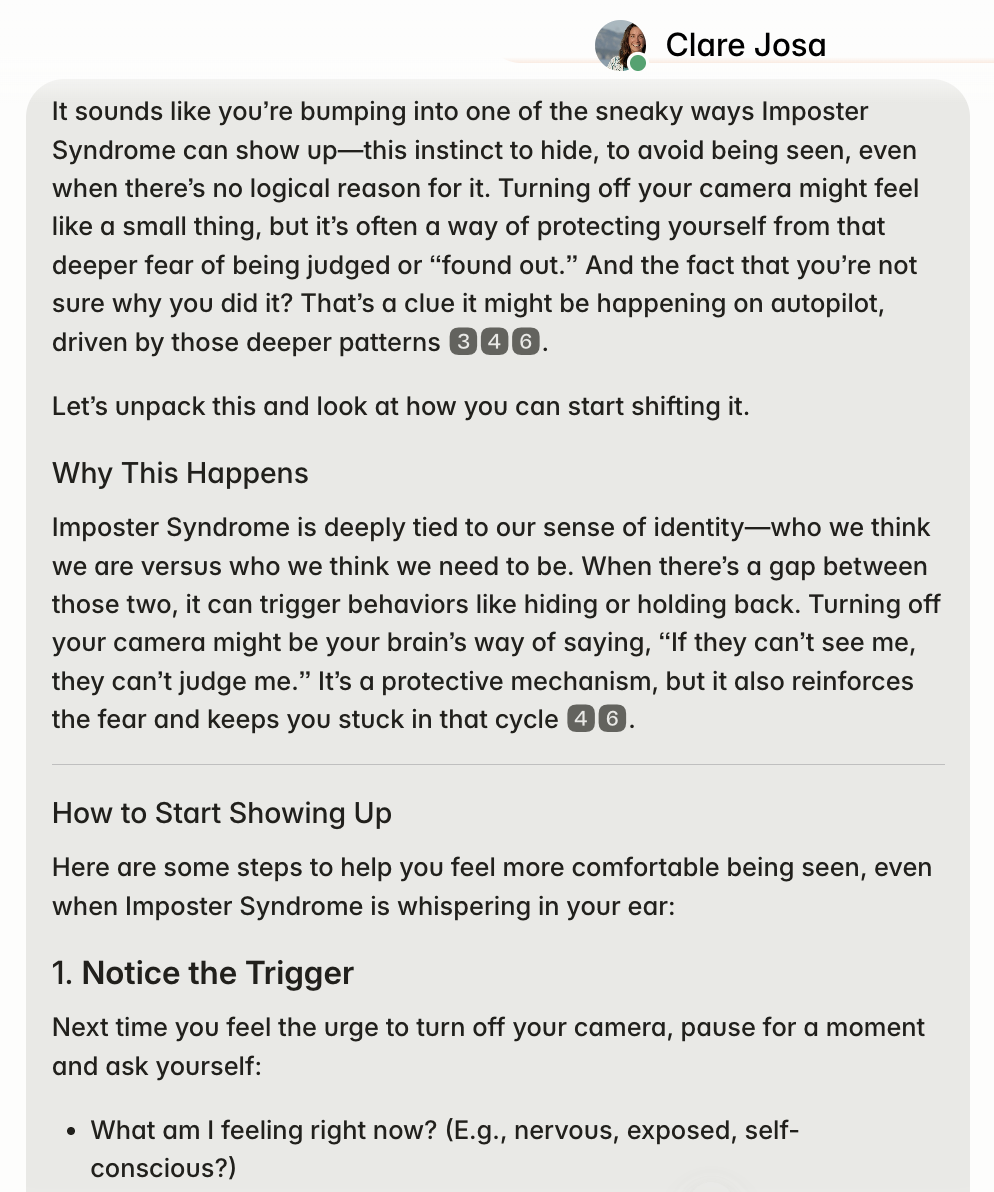
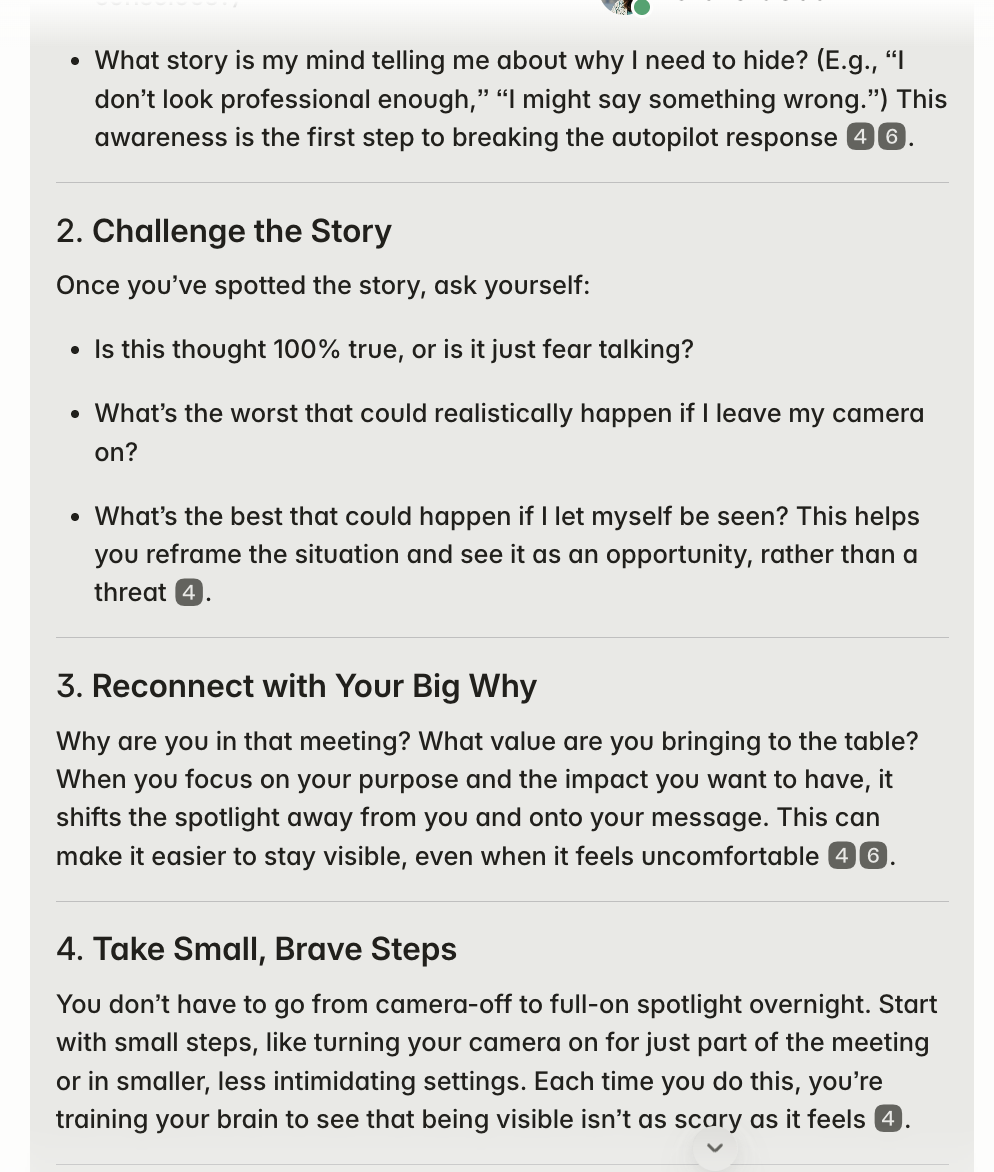
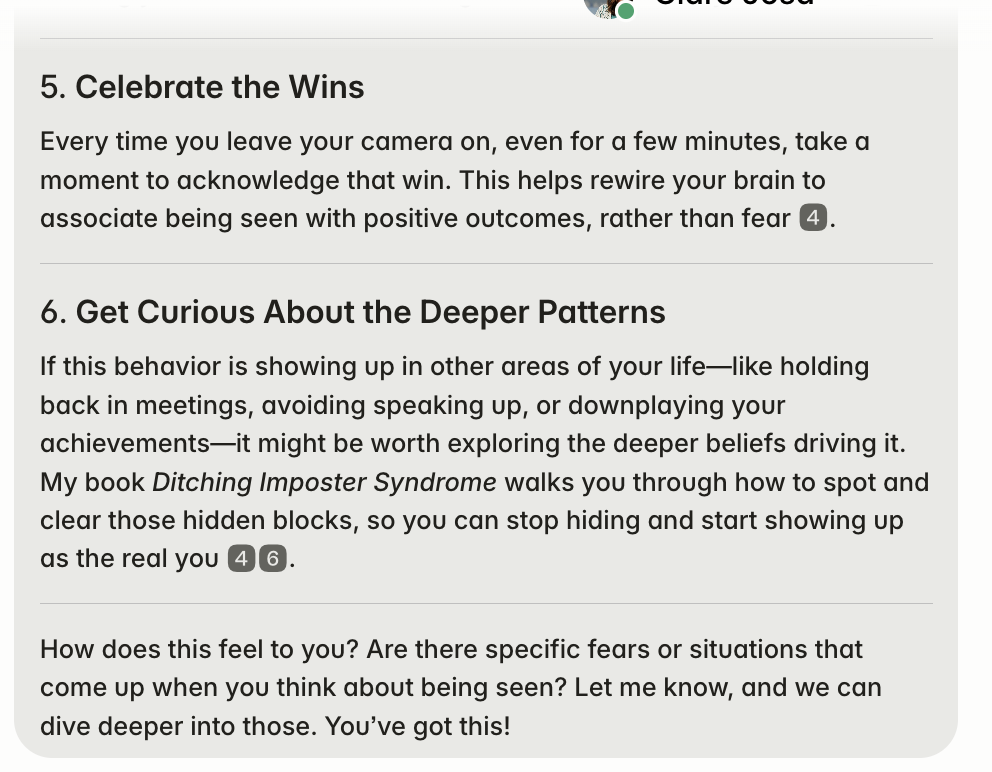
Here are the screenshots of this interaction. The numbers are links to resources and references, for people who want to dive right in and take more action.

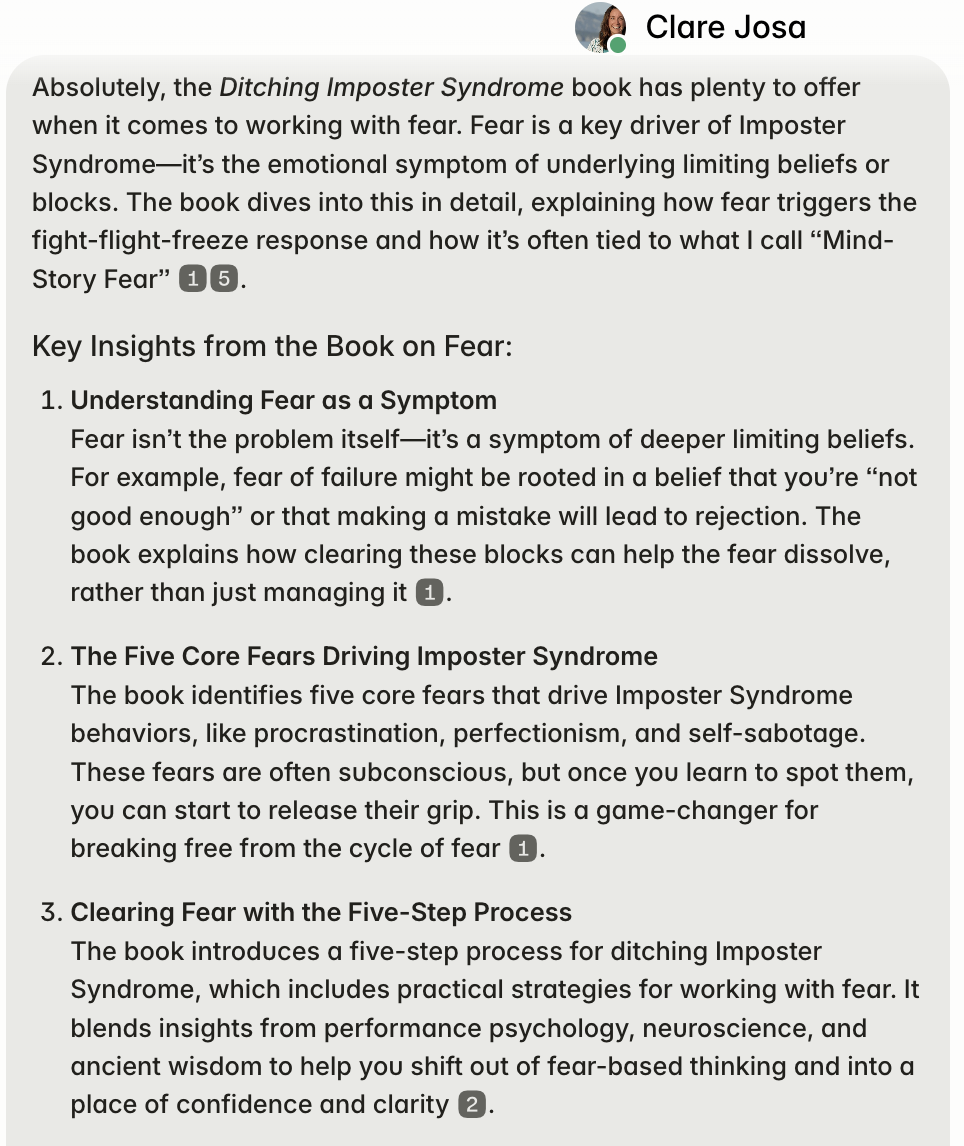
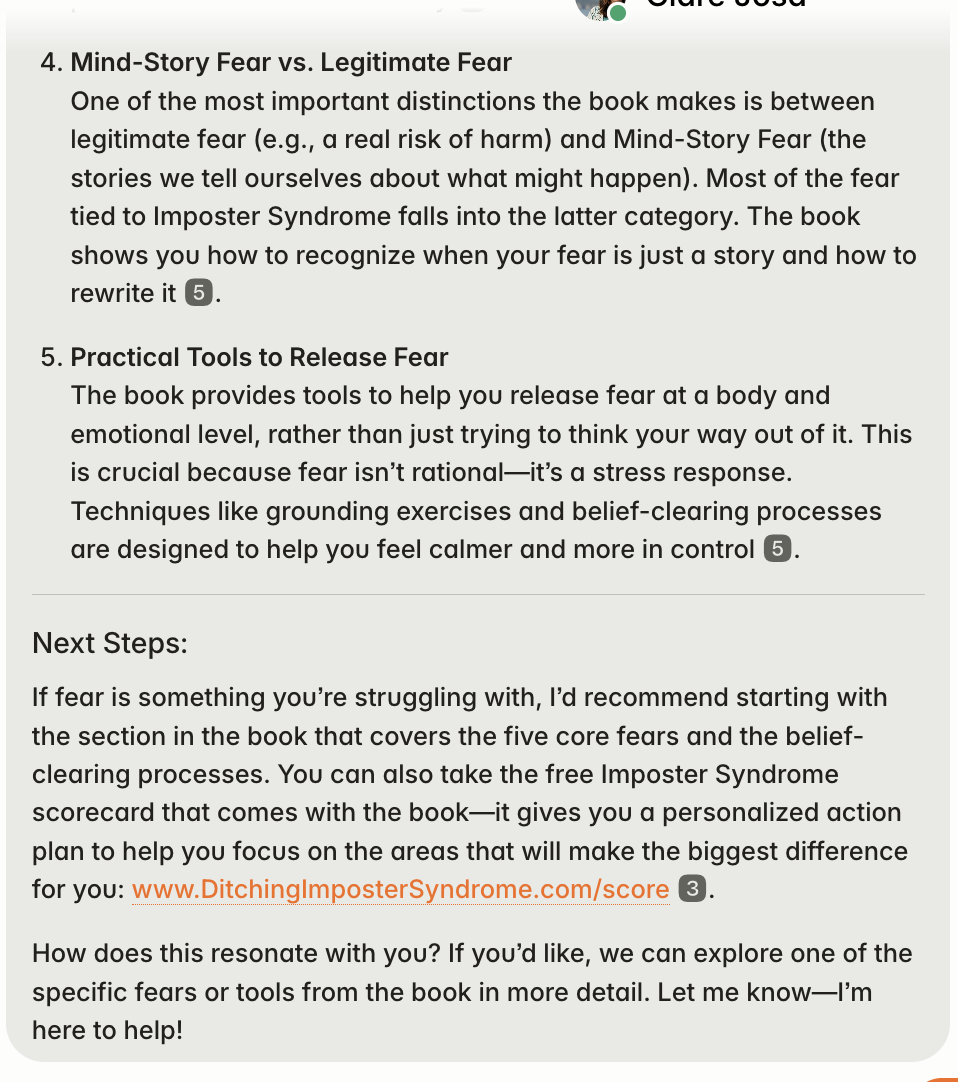
Here are the screenshots of this interaction. The numbers are links to resources and references, for people who want to dive right in and take more action.

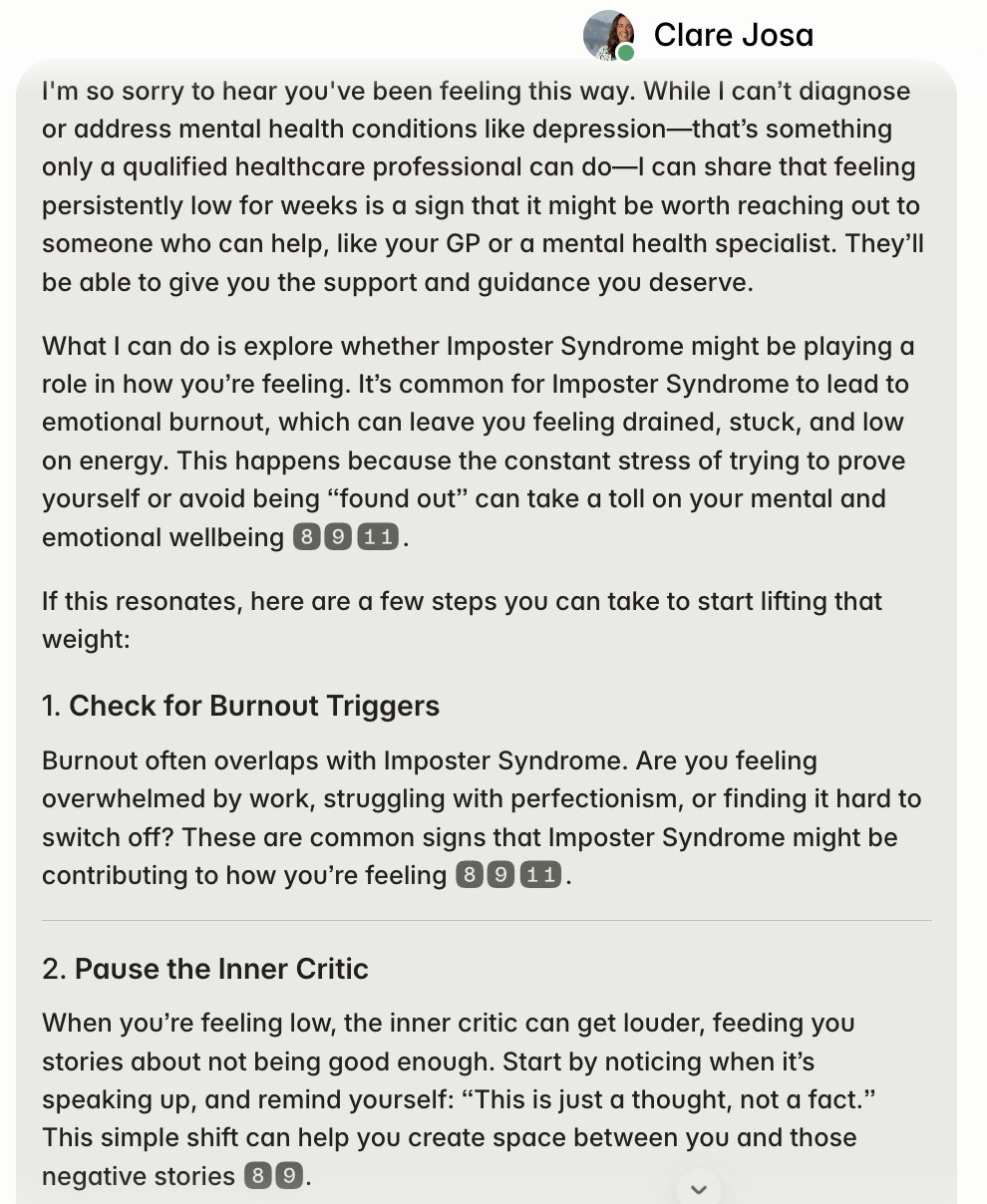
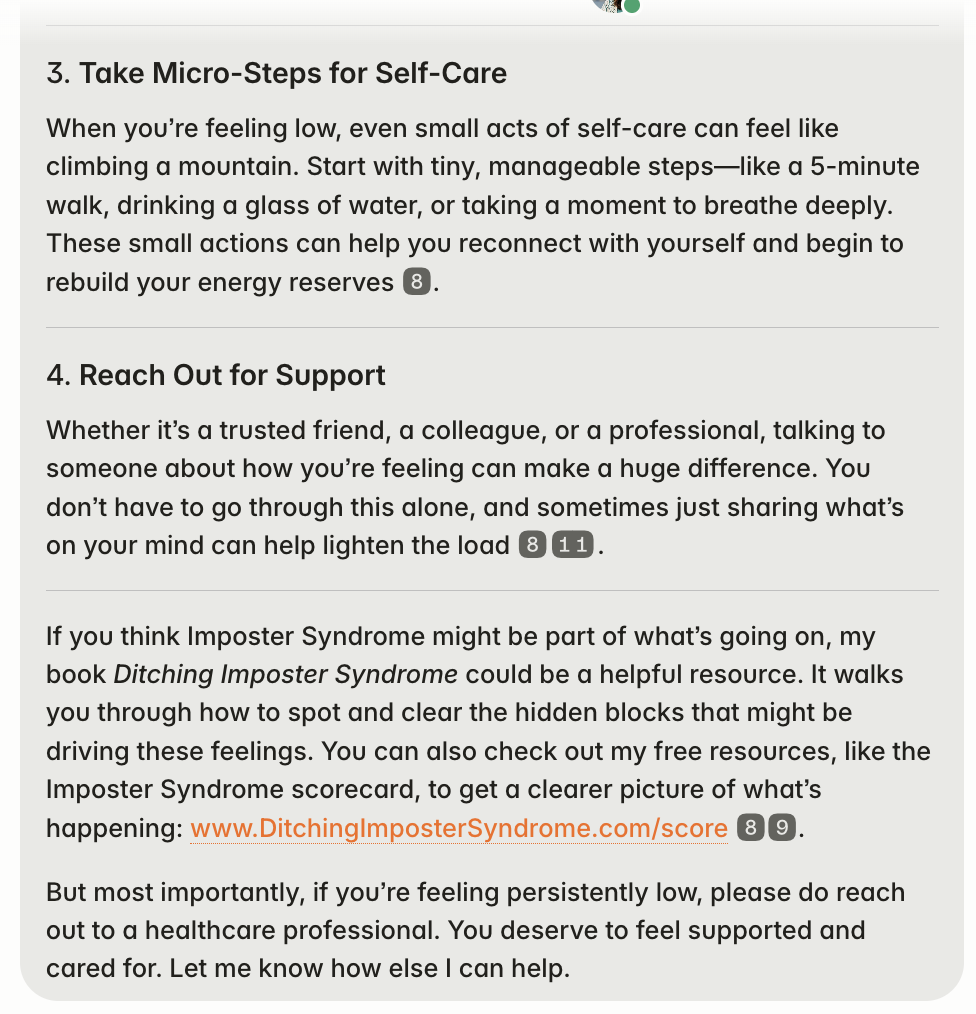
Imagine the life-changing difference this could make for you and your teams.
Demand is high and we're releasing licences on a first-come, first-served basis. Register below to claim your space in the waiting list.

